JAGUARS and the Wildlife
of the Pantanal
Photo Tour
August 2016
Trip ONE Report
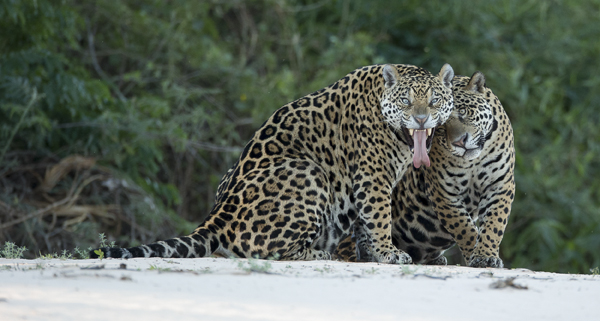
While we were concerned about potential crowds and lots of boats in Jaguarland,
we had a strategy ... we had this pair of males
for over an hour -- all by ourselves,
while everyone else was, apparently, jammed up on the main river!
All Photos by Joe McDonald.
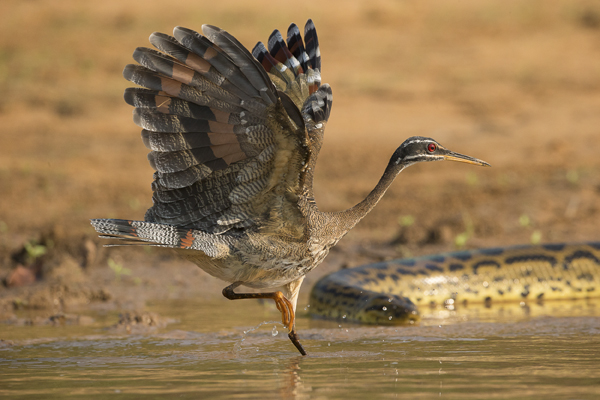
On our first afternoon in Jaguarland we had a ten foot long Yellow Anaconda being
harassed by a Sunbittern. The bird displayed often, revealing its wing eyespots.
Day One – Sao Paulo to South Wild Lodge
Perhaps because of the Zika scare our first Pantanal Trip was poorly attended. My good friend Tom, who accompanied me on my very first scouting trip to the Pantanal eight years ago, and another friend, John, who has traveled to Kenya with us, make up our little group. John arrived in Brazil several days earlier to photograph Iguazu Falls, and met us yesterday evening at the Mariot, where we all were staying. This morning John did a graffiti city tour, expected to return at 11AM, but at 12:30, when we were scheduled to head to the airport, no John! Traffic had held him up and his driver was kind enough to wait as John checked out, and delivered him to the airport in plenty of time.
Meanwhile, I searched the airport for a Simms card for my phone, and Tom and I arrived at our gate later than John! We boarded reasonably early, so there was no carry-on space issue, and arrived in Cuiaba around 5PM. Sunset is around 5:40, so our nearly four hour drive to South Wild, our first stop, would be in the dark. Our outfitter screwed up and had a very 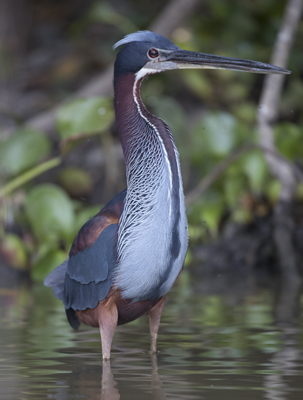 small hatchback ready for us, and with the amount of duffles and gear we had it was a tight fit. Our driver was incompetent at packing, so I took over and got us enough space for some degree of comfort. Despite the rather cramped conditions, I still looked forward to that, hoping to see some nocturnal mammals long after dark, but aside from one dubious view of a Javelina, and what may have been a cat but was probably a Crab-eating Fox, we saw nothing but Nightjars. We arrived at the lodge shortly after 9PM, very tired from a long day of travel.
small hatchback ready for us, and with the amount of duffles and gear we had it was a tight fit. Our driver was incompetent at packing, so I took over and got us enough space for some degree of comfort. Despite the rather cramped conditions, I still looked forward to that, hoping to see some nocturnal mammals long after dark, but aside from one dubious view of a Javelina, and what may have been a cat but was probably a Crab-eating Fox, we saw nothing but Nightjars. We arrived at the lodge shortly after 9PM, very tired from a long day of travel.
Day Two – South Wild to Pouso Alegre
Our itinerary is a bad one in the sense that we had to backtrack today, heading back up the Pantaneria Highway, to our next lodge. However, the wildlife there is often much better than at South Wild, and getting two days here would be productive.
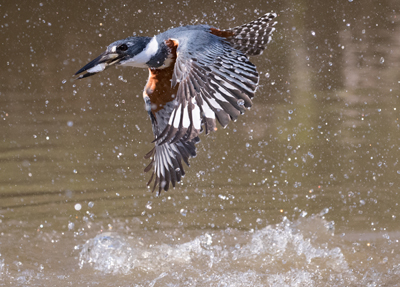 Our morning at South Wild, however, was fantastic. At 7:30AM we took a boat up river to photograph the Black Hawks, Black-collared Hawks, and Ringed Kingfishers that fly in for the fish tossed to them. After having a nice session with a Black Hawk we continued upriver, and found the most cooperative Agami Heron I’ve ever had. This is considered the most beautiful of the New World Herons, and perhaps for the entire world, and normally this stunner frustrates birders and photographers by staying in the deepest cover. This one, this morning, was in shade, but in an open area where a full-frame camera with a 400mm lens was too much lens! We got some great shots.
Our morning at South Wild, however, was fantastic. At 7:30AM we took a boat up river to photograph the Black Hawks, Black-collared Hawks, and Ringed Kingfishers that fly in for the fish tossed to them. After having a nice session with a Black Hawk we continued upriver, and found the most cooperative Agami Heron I’ve ever had. This is considered the most beautiful of the New World Herons, and perhaps for the entire world, and normally this stunner frustrates birders and photographers by staying in the deepest cover. This one, this morning, was in shade, but in an open area where a full-frame camera with a 400mm lens was too much lens! We got some great shots.
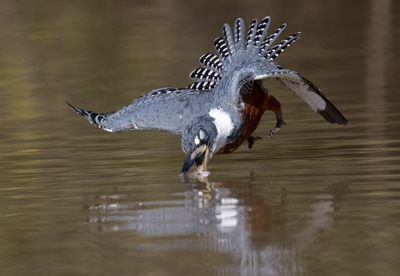 We continued upriver, eventually getting a Black-collared Hawk, but it was the Kingfishers that were the show. We had plenty, and this early in the trip our reflexes and shooting was a bit lacking, but despite this, we all managed some nice keepers. Personally, I missed a lot! I stunk.
We continued upriver, eventually getting a Black-collared Hawk, but it was the Kingfishers that were the show. We had plenty, and this early in the trip our reflexes and shooting was a bit lacking, but despite this, we all managed some nice keepers. Personally, I missed a lot! I stunk.
Continuing upriver we encountered a trio of Giant Otters that we’d seen last year. Now, these otters are completely habituated, and swim to the boats expecting fish. Another boat came up, and one of the otters practically climbed into the boat to get the fish he was dangling. Although we did get nice headshots, I certainly prefer the wild otters we’ll find on the river later on.
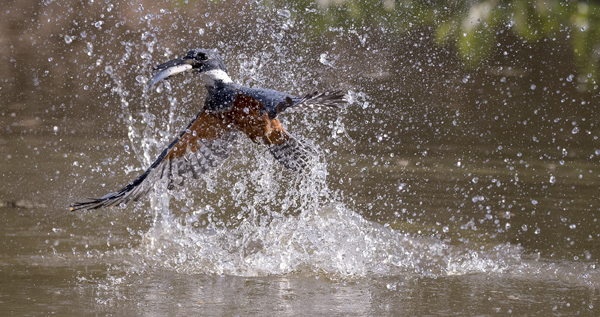
After lunch, we packed our duffles in the night game drive truck, and only carried our camera gear in the little car as we made the one hour commute to PA. Driving now in the daylight I could see how incredibly dry the area is for this time of year – virtually no water along the roadsides. Today was hot, and when we arrived at 3PM it was still over 100 degrees. We scheduled our ‘night game drive’ for 4:15, and headed out to a waterhole where we’ve had luck in the past.
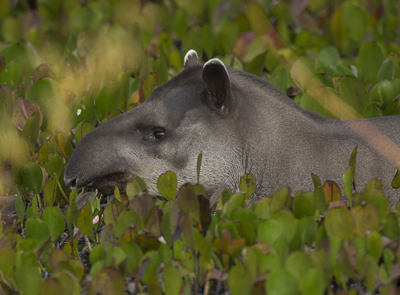
We had exceptional luck this evening. A troop of Coatimundis passed, too far away for shots, but while we were distracted and entertained by them a Brazilian Tapir entered the pond. With big ears ringed with a thin white fringe, it was striking, and we managed some decent shots as it plodded across the hyacinth-filled pool. Later, two Crab-eating Foxes groomed each other, and I set up for action, but they never played. Instead, a Giant 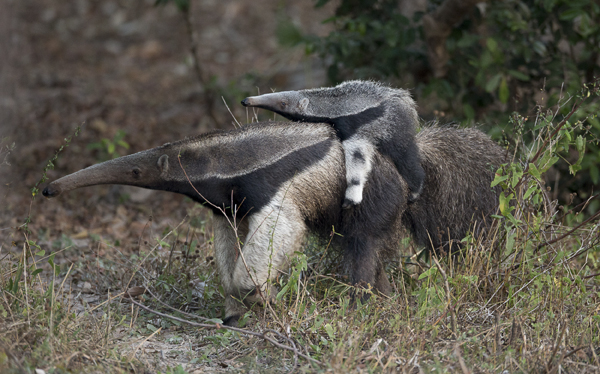
Anteater appeared, with a large baby riding on her back, and eventually the Anteater circled and we shot some great front-on views.
We waited until dusk, and then did a laborious night game drive that yielded nothing until the very end, when I spotted a Lesser Anteater (aka Collared or Lesser Tamandua) with a baby on her back walking near the road. Unfortunately she reacted to the spot light and turned back into the brush, so we were merely treated to a wonderful view, and not to any shots. Still, it was the first time I’d seen a Tamandua with a baby, and to have both species with babies in one afternoon was simply stellar.
We returned to the lodge by 7:15, discovering dinner wouldn’t be served until 7:30, so we had plenty of time to relax (15 minutes!). The internet was sufficient that I could Skype Mary and position the laptop’s camera to show Tom’s computer screen and the anteater photo he was displaying. It was a great day, and I kept on stressing to John how incredibly lucky he was for the first day here. He was really luck in Kenya, too, so it bodes well for us.
Day Three – Pouso Alegre
I was out before sunrise, greeted by a hazy, potentially stormy dawn, with a red fireball rising across the marshes. Somewhere to the east, perhaps the second woodlot over and half mile away, Howler Monkeys heralded the dawn, with their deep, quite unmonkey-like roars. At times the Howlers sounded like ocean waves, a cascading rush of rising and falling notes, at other times choking into gurgling roars. I walked out to look, but with thick brush between us and no monkeys visible as silhouettes in the distant trees, I turned back. Hoping for tapir or marsh deer, I walked out to the elevated boardwalk that spans a now-drying marsh, but aside from some skittish 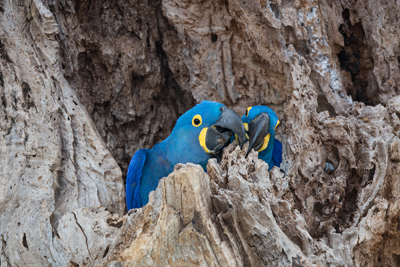 Limpkins the area was empty. Returning to the lodge’s grounds, I photographed a cooperative pair of Hyacinth Macaws at a natural cavity. At one point another pair flew in, perhaps to steal the nest site, and the birds exploded in squawking. I’ll assume the residents won.
Limpkins the area was empty. Returning to the lodge’s grounds, I photographed a cooperative pair of Hyacinth Macaws at a natural cavity. At one point another pair flew in, perhaps to steal the nest site, and the birds exploded in squawking. I’ll assume the residents won.
Louise, the lodge owner, asked if I’d like to check out some new areas, and I welcomed the chance. We started at a Roseate Spoonbill/Wood Ibis nesting colony. We drove to the site, parked about 200 yards away, and walked across the uneven, lumpy pasture – once 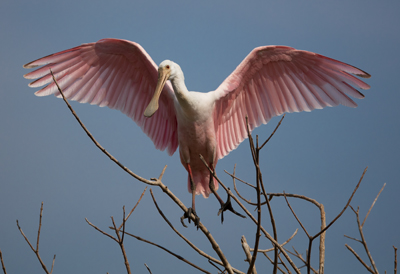 underwater, until we reached a large pool, with the nests in tall trees opposite. A Campo Flicker, Black-collared Hawk, Donocobius songbirds, and Caimans were scattered around the shoreline. The birds were good, and worth revisiting.
underwater, until we reached a large pool, with the nests in tall trees opposite. A Campo Flicker, Black-collared Hawk, Donocobius songbirds, and Caimans were scattered around the shoreline. The birds were good, and worth revisiting.
Leaving the rookery, Tom spotted a Tamandua walking across the open pasture, and headed to a brushy thicket. Knowing we’d lose the anteater there, I grabbed my 800 and tripod, and ran to head the anteater off. I thought I’d block its passage, but the anteater didn’t care and continued walking towards me, far too close for my lens. It stopped only feet away, and I signaled for my driver to take my place and block the anteater while I 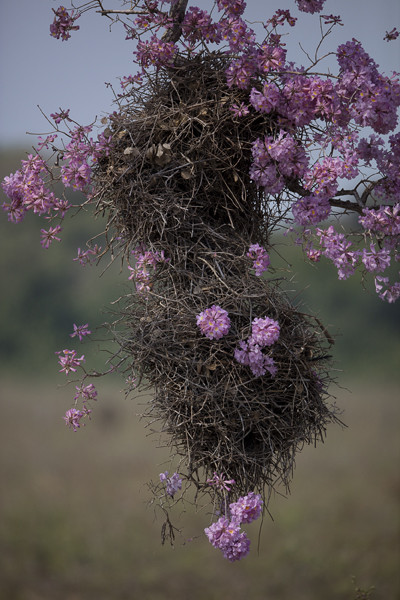 ran for a different lens. Whether it just walked on by, or he was a bit afraid, I don’t know, but the anteater went into the brush, and stayed there. John, who was shooting while I was blocking, got some nice shots, and Tom managed a few, too. I did not!
ran for a different lens. Whether it just walked on by, or he was a bit afraid, I don’t know, but the anteater went into the brush, and stayed there. John, who was shooting while I was blocking, got some nice shots, and Tom managed a few, too. I did not!
We continued on to the ‘hide,’ where I looked for the Collared Forest Falcon nest – either unsuccessfully or the nest was empty. A Nunbird perched unafraid nearby as the driver and I walked about, and Hyacinth Macaws squawked overhead. Back at the pond, we cut down some of the annoying weeds that were blocking a clear view of the pond. The entire area had previously been cut, but there were a few that missed a cutting, and these were problematic. Hopefully, no longer.
We finished the morning at a Jabiru Stork nest, with one adult and three half-grown chicks. They did little, and the light was a bit dull. 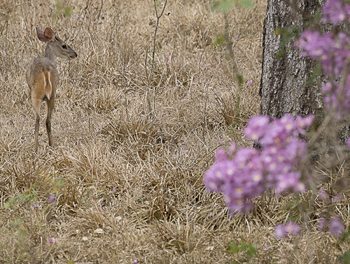 Shooting some record shots, and ISO comparison shots with the 5D rs, we started back to the lodge – delayed by a good shooting opportunity with a Brocket Deer.
Shooting some record shots, and ISO comparison shots with the 5D rs, we started back to the lodge – delayed by a good shooting opportunity with a Brocket Deer.
After lunch, the somewhat ominous-looking skies grew more threatening, with the northern horizon covered in a gloom of gray, thunder rolling, and a cool breeze. As I write this we may miss the rain, but the afternoon shoot will be a low light situation, to be sure!
PM. The storm missed us. At 2:30, bored, I borrowed a bicycle and rode back to the location where we had the Tamandua, but it was gone. I also explored ‘the jaguar forest,’ where Louise, the lodge owner, was leading a hike when, somewhere above them, a great roar enveloped the forest. They exhibited, without running, but terrified. I saw nothing there today, but in the overcast light of the post-storm skies I wished I had had my wide-angle for landscapes. As it was, I did some with an Olympus 4/3rds, at 80mm.
We left at 4PM, under a clear western sky. The storm had cooled the air, although waiting at the waterhole in the sun it was hot. I sat beneath the truck, in the shade, where I waited until 4:45, then reentered the truck for our last 45 minutes. The same pair of Crab-eating Foxes we had yesterday milled about the area, either giving a plaintive whinny call, or a harsh bark that reminded me of an alarm bark of a Jackal. Most of the time, the two just curled up and slept.
Nothing came to the pond, despite our efforts at gardening it clear, and at 5:30, at dusk, we headed back to the lodge. Earlier, during the storm, we had lost power, and we returned to a lodge in the dark, but by 7 the power was restored. Our driver headed on to Pocone’ after I gave him his tip, and at this point we are without any vehicle for our trip to Porto Joffre tomorrow. Hopefully our outfitter is on top of things, and a vehicle will be here and waiting for us. Tonight, because of the storm, it is pleasant, and sitting out as we were, waiting for the lights to hopefully return, and drinking a liquid dinner (beer), there were no mosquitos. Ironic, since the worry about Zika has depressed tourism this year.
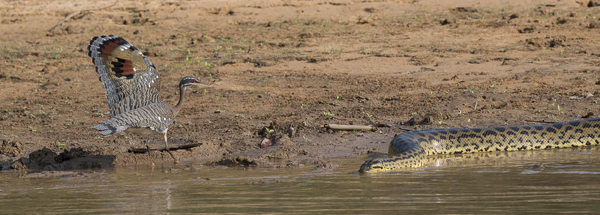
Day Four. Pouso Alegre to Flotel (Jaguar Country)
Our concerns about being marooned without a vehicle were unfounded – a tourist van, with plenty of room, arrived at 7:30AM and shortly after 8AM we headed southeast towards Porto Joffre. The state of the wooden bridges is the worst I’ve ever seen here, and many are now gone, removed completely in preparation for replacing these bridges with steel structures. Some are already in place, and operable, but others are gone, and dirt trails circle the site of the old bridges. The rainy season starts by December, and I wonder if the missing bridges will be replaced by the beginning of the rains. Could be interesting.
We arrived at Porto Joffre shortly after 11, record time, including a stop for the Great Horned Owl area, where we saw two full grown but fluffy babies. We didn’t bother photographing the birds, high in the trees and backlighted, and drove on, recording Snail Kites and Southern Screamers. We were met at the dock by one of my favorite boatmen, John, who will be our boatman for the entire tour.
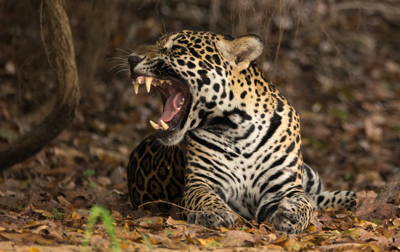 At lunch, our outfitter rushed in to tell us that a big male Jaguar had been spotted 20 minutes up river, and he was sending a boat up to see if it was still there. He suggested we be ready in twenty minutes just in case, but we left anyway, early, and headed up river. Meanwhile, en route, our outfitter was returning, informing us that the Jaguar had left. My boatman decided to continue – a course I’d have suggested if he didn’t, and we found the Jaguar! She (it was a female) was standing beneath a brushy deadfall, then sat and laid down, as we photographed. Later, she rose and disappeared, but our boatman kept up with her, actually surprising me because he’d motor much further upriver than I thought the cat would travel, but within minutes she was where we waited. We stayed with her for about a mile of river, and had several shooting ops, with no one else around. A great way for John to be introduced to the Pantanal and Jaguar Country!
At lunch, our outfitter rushed in to tell us that a big male Jaguar had been spotted 20 minutes up river, and he was sending a boat up to see if it was still there. He suggested we be ready in twenty minutes just in case, but we left anyway, early, and headed up river. Meanwhile, en route, our outfitter was returning, informing us that the Jaguar had left. My boatman decided to continue – a course I’d have suggested if he didn’t, and we found the Jaguar! She (it was a female) was standing beneath a brushy deadfall, then sat and laid down, as we photographed. Later, she rose and disappeared, but our boatman kept up with her, actually surprising me because he’d motor much further upriver than I thought the cat would travel, but within minutes she was where we waited. We stayed with her for about a mile of river, and had several shooting ops, with no one else around. A great way for John to be introduced to the Pantanal and Jaguar Country!
Now about 3PM, we headed back towards the main river, stopping a short time later for a family of Giant Otters. We had followed them for only a short distance when we received a radio call that an Anaconda had been spotted, just upriver from where we were. We raced to the site, finding a 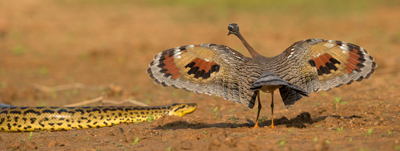 Sunbittern in full display, circling and pestering the oblivious Yellow Anaconda. The shooting was fast and furious, and I thought I screwed up most of the shots (turned out, I didn’t), and eventually the snake went into the water and swam off. But it returned to shore, where we left it, with the Sunbittern apparently harassing, or looking for, another Anaconda that had been with the first. I’m thinking the one we saw was a female (they are big) and the second a male, chasing her for mating. Another boat saw the second one – we did not.
Sunbittern in full display, circling and pestering the oblivious Yellow Anaconda. The shooting was fast and furious, and I thought I screwed up most of the shots (turned out, I didn’t), and eventually the snake went into the water and swam off. But it returned to shore, where we left it, with the Sunbittern apparently harassing, or looking for, another Anaconda that had been with the first. I’m thinking the one we saw was a female (they are big) and the second a male, chasing her for mating. Another boat saw the second one – we did not.
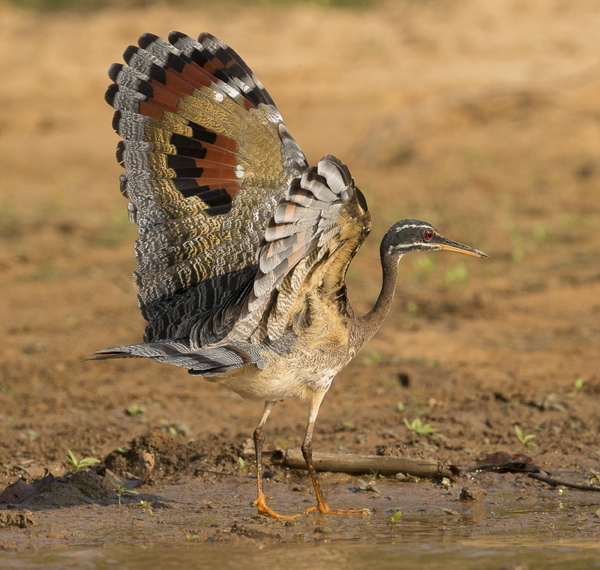
We started motoring back to the main river but I turned around and saw that the Sunbittern was now running up the river’s edge, and I was sure it was going to start harassing the Anaconda again. We turned, and this time positioned ourselves with the sun full to our backs, for great directional light, as the bird spread its wings and postured, as the snake slowly crept by. Sunbitterns are distinctive in that they have two false eyespots on their wings, displayed by the bird fanning its wings out. At a nest, the bird will face an intruder, fan its wings to display the eyes, and fold the wing edges forward, so that the bird and its fake eyes are both aimed at the threat. For predators, like hawks and this snake, the bird simply raised its wings, and we only had eyespot views from behind – the bird didn’t fold its wings forward. Still, it was an incredible show and something I’ve never seen before.
We continued on, hearing about another Jaguar in the main river. When we arrived about 20 boats were dispersing – people did get shots, but apparently it was a hectic scene. We continued upriver, almost reaching the great sandbar when we were radioed again – the Jaguar had returned. We raced down, but missed it, and continued down river to the Black Lagoon where we explored for a short time. The light was failing, and we had had a great day, and while we still had light to travel by we headed home.
Day Five. Jaguarland
We had breakfast at 6AM to be ready for a 6:30 departure under a sky that was slightly overcast and threatened bad weather later in the day. That, however, did not happen, although for much of the morning there was some overcast, so the weather, and conditions, were great.
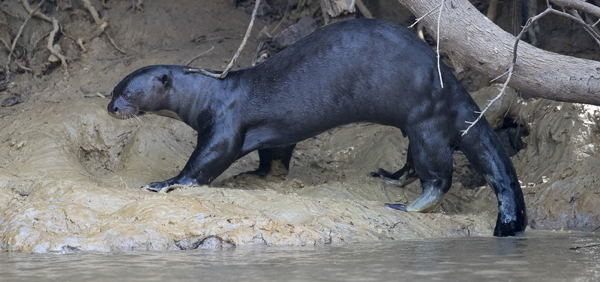
We headed up to the Three Brothers area, exploring the Black Lagoon, Charles Creek, and, finally, a tributary that led to the Cuiaba River. On the main river we encountered six Giant Otters that appeared to be headed back to their den. We followed them, down river, for at least two miles, where they turned up the Cuiaba and eventually settled at a deadfall where their den was. How’d I know this? At this time of day otters generally commute home, but more telling, these otters did not bother to fish. Only twice, in two or three miles, did they catch any fish, whereas, in a normal hunting foray, they’d have a fish every few minutes.
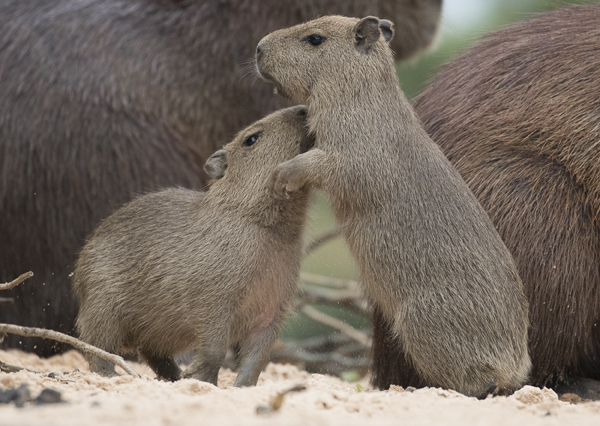
We spent about an hour with a family of Capybaras, three adults and two babies, and although the babies finally woke up, they didn’t play, and the shooting was rather tame. We headed onward, reaching the Cuiaba River where we photographed Jacare’ Caimans with their mouths gaping wide, where we also received a radio call that a Jaguar had been seen. It took us 40 minutes to arrive, on another tributary of the Three Brothers, where the mother Jaguar and nearly full-grown cub gave us tantalizing glimpses through the brush and trees. At 12:10 I decided the wait wasn’t worth it, and we headed back for lunch. All the other boats soon joined us.
PM. We were headed back towards the mother when another boatman signaled to us that a Jaguar on the main river was crossing towards the Black Lagoon.
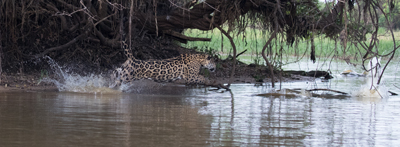
We did a U-turn and headed that way, and were in a prime position when the female Jaguar finally appeared. During the next hour we photographed
her as she unsuccessfully charged a Caiman, did a lengthy flehmen display where a male (presumably) had scent marked earlier – sometimes just 25 feet away, and where, when the Jaguar moved from deep shade to the open edge of the marsh, I forgot to change exposures! I 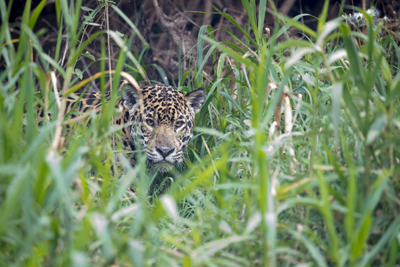 shot 20 shots before I realized I was off, then corrected myself (the image on left). I’d been off by 2 stops, but in the RAW converter I brought back the shots, and all was not lost.
shot 20 shots before I realized I was off, then corrected myself (the image on left). I’d been off by 2 stops, but in the RAW converter I brought back the shots, and all was not lost.
Eventually the Jaguar moved back into the interior, and we doubled back to the Charles Creek where we waited nearly an hour, expecting her to return. She did not. We returned to the main river, heading to the mother and cub, but the day was drawing to a close and some of the Flotel’s other boats were just returning from there, unsuccessfully, so we headed back to home. It was, however, a spectacular afternoon of Jaguar shooting.
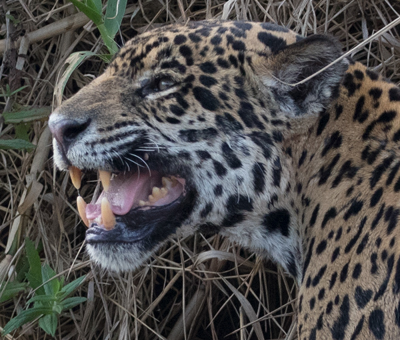
Day Six. Jaguarland
A thunderstorm and soaking rain during the night ushered in an Antarctic Cold Front. The day started gloomy with a threat of serious rain, and cold. How cold? I’m a wimp and I like to be warm, so I was wearing long pants and rain pants, a T-shirt, light long sleeve shirt, a medium weight vest, a light weight down jacket, and a rain jacket on top. A wool cap under my floppy ball cap, and sun gloves completed the outfit. During the morning we had a few light sprinkles, but as the morning progressed the skies cleared, although the wind that was present all morning persisted through the day.
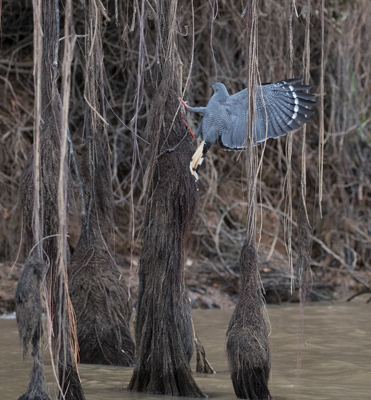 The day started slow, but that was fine as we’ve had plenty of Jaguars and we were happy to attempt to photograph baby Capybaras playing – they quit soon after we’d start. We had a great Crane Hawk, the South American ecological equivalent to the Gymnogene or African Harrier Hawk. This one hung from thin vines dangling to the river, groping about in the thicker areas, probably searching for frogs. We traveled far up the Three Brothers river, and upon our return encountered multiple boats staked out at a Jaguar and cubs. We eventually saw the mother and one cub, but there were no photos, the vegetation was thick, and we decided to leave the crowds and go to lunch.
The day started slow, but that was fine as we’ve had plenty of Jaguars and we were happy to attempt to photograph baby Capybaras playing – they quit soon after we’d start. We had a great Crane Hawk, the South American ecological equivalent to the Gymnogene or African Harrier Hawk. This one hung from thin vines dangling to the river, groping about in the thicker areas, probably searching for frogs. We traveled far up the Three Brothers river, and upon our return encountered multiple boats staked out at a Jaguar and cubs. We eventually saw the mother and one cub, but there were no photos, the vegetation was thick, and we decided to leave the crowds and go to lunch.
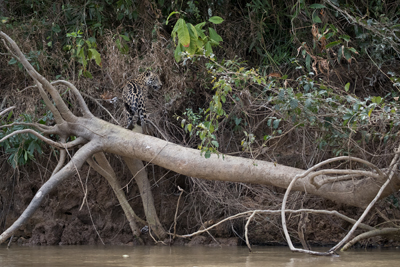 Along the way we received a radio call that another Jaguar had been spotted south on the Cuiaba River. We headed there just in time to see the cat disappear, but within ten minutes it reappeared and performed nicely. At one point it ran across one log, ducked into cover, and jumped on a large tree trunk stuck in the river – close to the dream shot I’ve wanted. Eventually the cat settled down and appeared to be going to sleep, so we headed back to lunch, arriving at 1PM.
Along the way we received a radio call that another Jaguar had been spotted south on the Cuiaba River. We headed there just in time to see the cat disappear, but within ten minutes it reappeared and performed nicely. At one point it ran across one log, ducked into cover, and jumped on a large tree trunk stuck in the river – close to the dream shot I’ve wanted. Eventually the cat settled down and appeared to be going to sleep, so we headed back to lunch, arriving at 1PM.
PM. We left at 2PM, heading back down the Cuiaba River to check that Jaguar. My boatman spotted another Jaguar about a half mile before we reached the morning’s Jaguar, and we had a great show, all to ourselves, until the mob, flotilla, horde of boats our boatman called in arrived. Prior to that, we had one great sequence where the Jaguar dove into the water after a Capybara, missed, got out, ran a few yards, and dove in again for another. I anticipated the second leap but it happened so fast – out of nowhere so I could not be set on a location – and all I caught was a great splash.
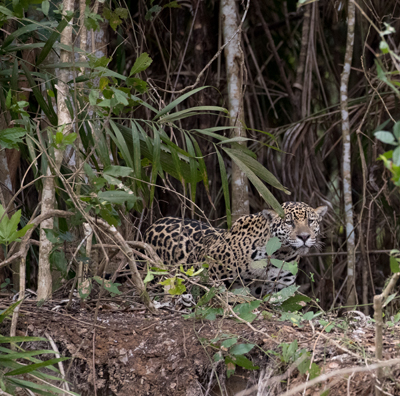 Perhaps attracted to the splash a Giant Otter appeared, barking a rattle, and the Jaguar, still in the water, quickly dashed to shore. The cat moved about twenty feet up the bank where it turned and watched the otter, who rose high in the water, chattering with annoyance, as if daring the Jaguar to enter its realm. The cat did not, and the otter finally swam off. Our boatman radioed downriver to the other boats, and soon our show would be over.
Perhaps attracted to the splash a Giant Otter appeared, barking a rattle, and the Jaguar, still in the water, quickly dashed to shore. The cat moved about twenty feet up the bank where it turned and watched the otter, who rose high in the water, chattering with annoyance, as if daring the Jaguar to enter its realm. The cat did not, and the otter finally swam off. Our boatman radioed downriver to the other boats, and soon our show would be over.
Eventually about 20 boats arrived, and when our Jaguar finally disappeared all of the boats headed downriver for the other cat. We did not, and quite content with the shooting we just had, we headed upriver to shoot whatever we would find.
Exploring Charles River, the Black Lagoon, and the site of the mother and cub from this morning, we filmed Black Hawk, Limpkin, Tropical Kingbird, and White-necked Herons. As we were heading back out of the Black Lagoon we received a call that another Jaguar was spotted, right at the mouth of the Lagoon. She was lying in the grasses, supposedly hunting but surely resting to me, but we finished the day with our boat anchored securely in the reeds, photographing this cat in the last light. In total, we saw 5 different Jaguars today, for a total now of 12. And we missed two, by arriving too late!
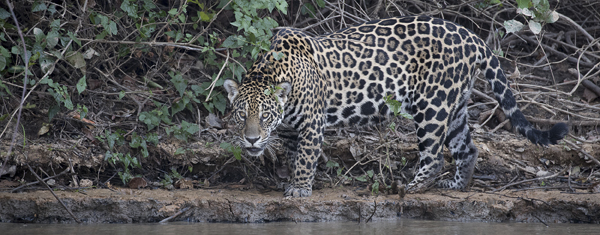
Day Six. Jaguarland.
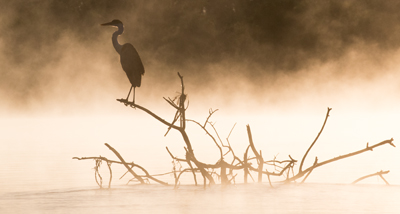
Two more Jaguars this morning, and we discovered that yesterday AM’s shoot had two Jaguars – as originally reported, and then confirmed by the Jaguar naturalist on board. This morning, in very cold weather with clear skies, we motored up the Cuiaba River for 1.5 hours until we reached the cross-over stream to the Three Brothers. We had several birds en route, but 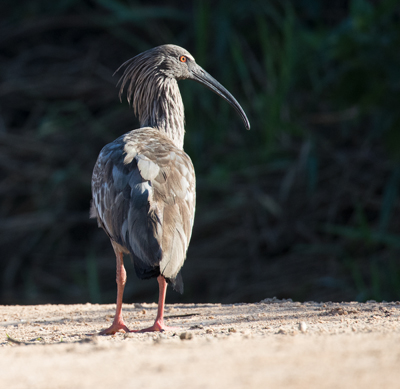 upon reaching the Three Brothers, and heading upstream, we had a male Jaguar with fresh scars on his snout. The cat was shy, and after laying down behind a bush it rose and walked off. Several times, while out of sight, the cat roared, an ‘uhh – oommm’ much like a tiger’s roar, or territorial announcement.
upon reaching the Three Brothers, and heading upstream, we had a male Jaguar with fresh scars on his snout. The cat was shy, and after laying down behind a bush it rose and walked off. Several times, while out of sight, the cat roared, an ‘uhh – oommm’ much like a tiger’s roar, or territorial announcement.
At the Charles River we had an Ocelot – the first I’ve had on the river. I managed a quick burst of 7, with 3 having the cat’s head clear, and sharp! We continued, and near the confluence of the Piquiri, we had another female Jaguar. She was hunting along the high bank, and downstream a family of Capybaras were on shore. We set up there, waiting and ready, but the rodents sensed her and dashed to the water. We did not see the cat again. We returned to the boat at 1.
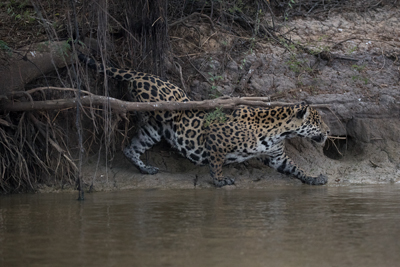
PM. We headed out at 2PM, and our Jaguar from this morning was still hunting. There was an entire flotilla of boats there, and at one point my boatman crossed a photographer’s line of sight. The photographer specializes on big cats, shoots at times for Nat’l Geo, and is a guy I’ve heard mixed comments about. At any rate, when we crossed in front of him the Jaguar was still in the reeds and out of sight, but appeared as we crossed. Mind you, the shot was no different than the dozens of other opportunities we had, but the guy then yelled to our boatman, ‘you do that again and I’ll cut your gas line.’ Which my boatman paid no heed. As we passed, I had actually ducked down low just in case we’d be in a shot, but another pro photographer, who I spoke with this evening, said that this guy is a real prima donna and stands in front of people whenever he wishes to. There are two sects of rules. Ironically, later this Jaguar crossed the river, and this guy was the one boat to zoom in, cutting across the path of every other boat, and positioning himself to be in front of the jaguar as it swam. Two rules.
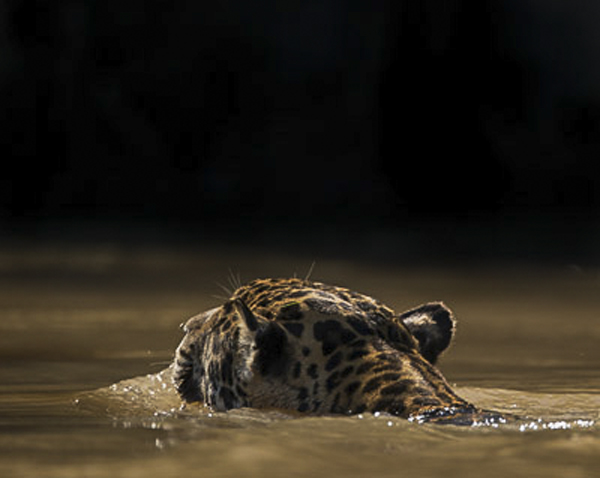
Once the Jaguar crossed, it was on the shaded side of the river and, fed up with the crowds, we headed up the Three Brothers River to see what we could see. As we motored, we received a radio call that another Jaguar was spotted on the Cuiaba River, and I was asked if we should go. Since all the other boats were there, I said no, we’d continue, and shoot whatever.
Cruising along, we photographed an immature Black-crowned Night Heron on the Charles River, then continued upriver towards the big sandbar. Meanwhile, the Jaguar on the Cuiaba made a kill, but the only shots were those as it carried off the kill (a caiman). For us, we found another Jaguar, lying beneath a bush behind a large sandbar. My boatman said he spotted another, and so we waited, and about 30 minutes later the two cats 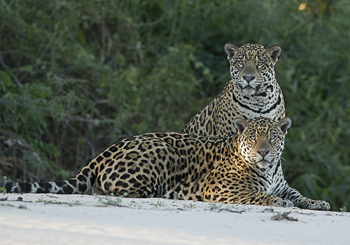 emerged. First, they only poked their heads above the sandbar, but we were quiet, and as time passed the two cats got up, nuzzled one another, mutually groomed, and posed innumerable times – two adult males that must be brothers, and a spectacular show that lasted over an hour. One other boat was there when we arrived, but that boat moved on, and for the entire show we were the only ones there. We were quiet, patient, and man, did we get the shots! It was spectacular, and at 5:25 we headed back to the Flotel for the evening!
emerged. First, they only poked their heads above the sandbar, but we were quiet, and as time passed the two cats got up, nuzzled one another, mutually groomed, and posed innumerable times – two adult males that must be brothers, and a spectacular show that lasted over an hour. One other boat was there when we arrived, but that boat moved on, and for the entire show we were the only ones there. We were quiet, patient, and man, did we get the shots! It was spectacular, and at 5:25 we headed back to the Flotel for the evening!
Day Seven. Jaguarland
Today was a slow day. It was even colder this morning, with mists rising in thick clouds from the river, but we missed the best light for morning mist. We headed up the Three Brothers, stopping for a Howler Monkey, Plumbeous Ibis, and my first-ever view of a Greater Ani, a huge bird, almost half a meter in length. Quite distinctive, with a purple green color and erect posture, but it flew off before I could get a shot. We arrived at the crossing point of the Cuiaba where we had a radio call that a Jaguar had been 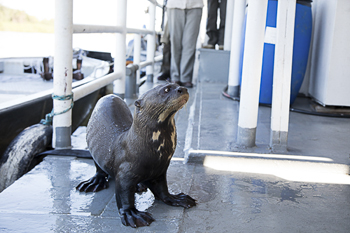 spotted about 10 minutes down the Cuiaba river. We turned around and went for it, but the Jag was gone by the time we arrived. We continued downriver, and soon had another call that a Jag was spotted on the Black Lagoon. We headed there, and I had a distant view, but that was it. At lunch, six Giant Otters visited the boat, with one actually coming onboard to beg for fish. The crew caught a couple of eel-like minnows, which the otter ate, grabbing the fish each time and diving back into the river to feed.
spotted about 10 minutes down the Cuiaba river. We turned around and went for it, but the Jag was gone by the time we arrived. We continued downriver, and soon had another call that a Jag was spotted on the Black Lagoon. We headed there, and I had a distant view, but that was it. At lunch, six Giant Otters visited the boat, with one actually coming onboard to beg for fish. The crew caught a couple of eel-like minnows, which the otter ate, grabbing the fish each time and diving back into the river to feed.
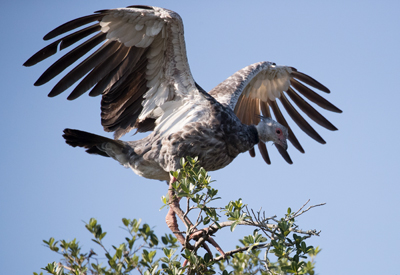 PM. At 2 we headed back up the Cuiaba for a 1.75 motor to the crossing point, stopping enroute for a Southern Screamer, which did not cooperate, and some muddy Capybaras. It was nearly 4PM when we reached the Three Brothers River, where we were just minutes too late for a glimpse of a shy Jaguar – perhaps the same shy male we had in that general area yesterday. We arrived back at the Flotel at 5:45 – as the air began to cool. Our butts were sore from all the sitting and no shooting!
PM. At 2 we headed back up the Cuiaba for a 1.75 motor to the crossing point, stopping enroute for a Southern Screamer, which did not cooperate, and some muddy Capybaras. It was nearly 4PM when we reached the Three Brothers River, where we were just minutes too late for a glimpse of a shy Jaguar – perhaps the same shy male we had in that general area yesterday. We arrived back at the Flotel at 5:45 – as the air began to cool. Our butts were sore from all the sitting and no shooting!
Day Eight. Jaguarland to Santa Teresa
We had a final run on the river, leaving in what was still a pleasantly cool/cold morning with silver mist rising from the warm river water. We heard of one report of a Jaguar on the Cuiaba, but we passed, continuing on 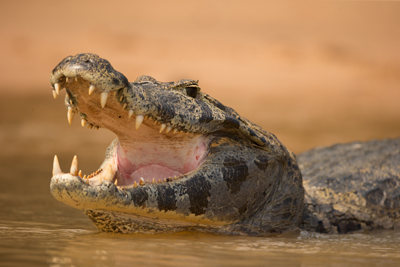 the Three Brothers and the various side channels. Ironically, as we completed the run, and were hoping to have an early departure from the Flotel to the mainland, we passed by Charles Creek and went a short distance up the Black Lagoon. About a half hour after we skipped the Charles Creek McJaguar, the one-eyed male that was a star the last few years, was seen on the beach at this creek, and probably visible from the main river. I wonder if we had explored that short water system if we’d have had him further upstream? It would have been nice to finish with this famous cat, but for those that did have him, it ended up to be somewhat of a nightmare. Apparently almost every boat on the river was jammed in this little creek, making for a real mess. I did not want to end my experience on the river in that way, so perhaps we were lucky.
the Three Brothers and the various side channels. Ironically, as we completed the run, and were hoping to have an early departure from the Flotel to the mainland, we passed by Charles Creek and went a short distance up the Black Lagoon. About a half hour after we skipped the Charles Creek McJaguar, the one-eyed male that was a star the last few years, was seen on the beach at this creek, and probably visible from the main river. I wonder if we had explored that short water system if we’d have had him further upstream? It would have been nice to finish with this famous cat, but for those that did have him, it ended up to be somewhat of a nightmare. Apparently almost every boat on the river was jammed in this little creek, making for a real mess. I did not want to end my experience on the river in that way, so perhaps we were lucky.
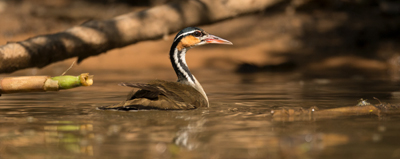
Our day was a good one, with at least nine species photographed by everyone, and 10 for some. The subjects included Rufescent Tiger-Heron, White-necked Heron, Boat-billed heron, Sungrebe (a real rarity), Giant 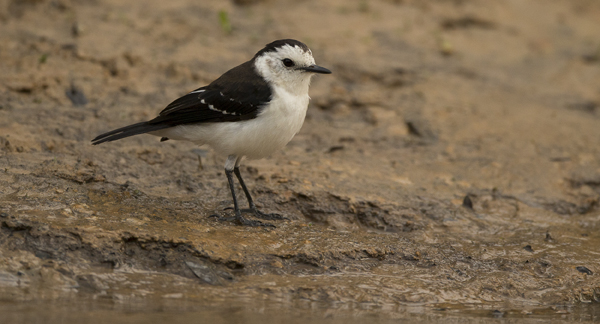
Otter – on a sand bank, Two species of Swallows, Roadside Hawk, Black-backed Marsh Tyrant, and Southern Screamer – perched high on a tree and flapping its wings, exposing the formidable spur on the elbow of its wings. Today was the first time this trip that we had an opportunity to photograph the ‘bubble dance’ of Caimans, where they vibrate the water into a fountain – probably as a courtship attractant.
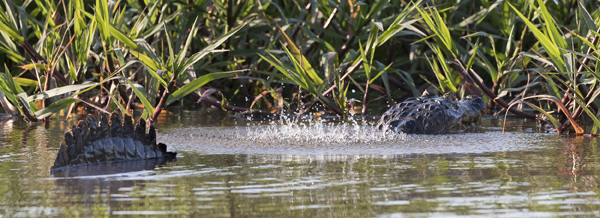
We hoped to leave early for the mainland but the terrible conditions of the bridges apparently held up our driver, and so we met her at 1:30, after only a 15 minute boatride downriver. The lady drove fast, and we arrived at the SouthWild lodge at 3:30. At 4:15, Tom and I went into the forest where I positioned 7 flashes for the Ocelot shoot that evening. The lighting was perfect.
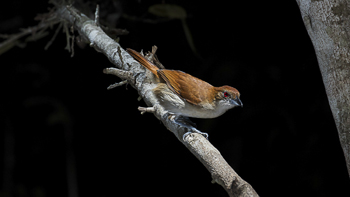
At 5:15 we headed to the forest, as we were told that the Ocelot sometimes arrives early. Two species of Shrike and Ant-shrike stole chicken pieces from the feeder – my lighting made for nice portraits, but no Ocelot ever arrived! We waited until 8:15, took down the flashes, and returned to the lodge by 8:30, to discover the food was put away. The manager prepared a more than filling plate for us, so we did have dinner. It was a disappointment not to get the Ocelot, although I do have the lighting worked out for the next trip – a bit too late for Tom and John!
Day Nine – Santa Teresa

Packing until late, I tried sleeping in to 6, although the Chachalacas woke me up earlier with their pre-dawn screeching. At 7:30 we did another boat ride for the hawks and kingfishers, and our boatman, the younger of the guys normally doing this, actually understood light and positioning, and we had our best run in a long time with him. We had two opportunities with Black-collared hawks, one with Greater Black Hawks, and probably a dozen times with Ringed Kingfishers. (Note: How easy it is to forget! In reviewing the images later, we had 33 chances at Kingfishers diving in for fish – not 12!). An Amazon Kingfisher is so tame it lands on the boat, waiting for fish, and at the end of the run the same bird landed on a paddle raised in the air, and then at the boat front, where it rode with us about a quarter mile.
The cold front is passed, and the morning, by 9:30, was hot! We spent the rest of the morning editing and catching up on work, and for Tom and John, packing for home.
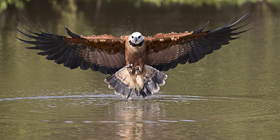
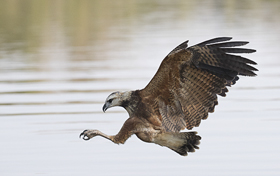
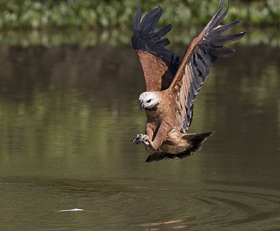
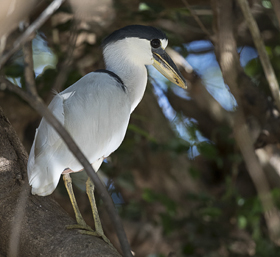
In the afternoon we headed for our lst stop, one of my favorite lodges, Curasaca, which will be an easy departure point for Tom and John’s trip to Cuiaba tomorrow. I set up a Range IR camera trap about a quarter mile into 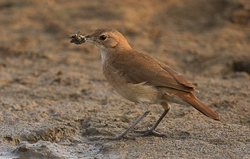 the forest on a game trail. I’d probably have done better putting the trap 50 yards into the forest, as game continually comes in to feed at their feeders, but I was hoping for a Tapir. At any rate, between scouting and setting up and then arming the traps I put a few miles in, back and forth. The rest of our evening was spent recounting the highlights of the trip – and for Tom and I it was getting away from the crowds and having parts of the rivers all to ourselves, like in the old days, as well as our usual highlights of the two jaguars together, the Agami Heron, infra images, and so much more.
the forest on a game trail. I’d probably have done better putting the trap 50 yards into the forest, as game continually comes in to feed at their feeders, but I was hoping for a Tapir. At any rate, between scouting and setting up and then arming the traps I put a few miles in, back and forth. The rest of our evening was spent recounting the highlights of the trip – and for Tom and I it was getting away from the crowds and having parts of the rivers all to ourselves, like in the old days, as well as our usual highlights of the two jaguars together, the Agami Heron, infra images, and so much more.
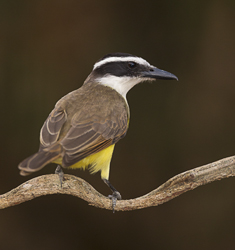
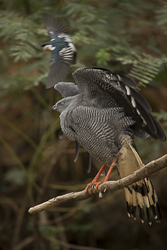
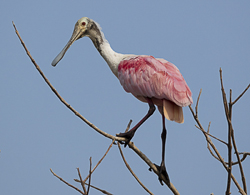
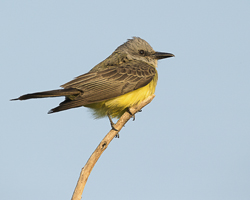
Day 10. Curicaca
Today, August 26th, was my birthday, and I had the vaguest plans to actually relax, edit, and recharge for the next group. It didn’t happen – not by a long shot.
I started the day by seeing off John and Tom, and then checking my camera trap. Nothing hit it, so I rearmed the trap with fresh batteries and repositioned the Range IR a bit differently, and let it go for the morning. I got some nice shots of Agoutis, flashed but balanced with the natural light.
Next, as I promised Mary, I did some video, with me talking into the camera at different angles about what the Pantanal has to offer. Doing so, I passed on the innumerable bird shooting opportunities I had. Later, I borrowed a bicycle from the lodge, and biked the two miles to the main road, and explored several locations around the area for shooting opps. I 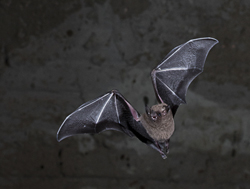 found a roost of bats – all nectar feeders (Pallas’s, perhaps) and unequipped with light stands I spent much of the rest of the day MacGyver-ing make-shift light stands out of bamboo. This required borrowing a hacksaw, and then lashing the pieces together, with a center pole for the 1/4x20 rods to hold the flashes. I hoped to borrow the lodge’s vehicle but it was in Cuiaba, so I had the owner call around and for $50 US two teen-agers from Pocone’ drove down to drive me and all the gear to the bats in the late afternoon.
found a roost of bats – all nectar feeders (Pallas’s, perhaps) and unequipped with light stands I spent much of the rest of the day MacGyver-ing make-shift light stands out of bamboo. This required borrowing a hacksaw, and then lashing the pieces together, with a center pole for the 1/4x20 rods to hold the flashes. I hoped to borrow the lodge’s vehicle but it was in Cuiaba, so I had the owner call around and for $50 US two teen-agers from Pocone’ drove down to drive me and all the gear to the bats in the late afternoon.
Because of an unusually hectic schedule before this trip, we didn’t finish packing until an hour before I left for Brazil. Consequently, Mary and I found I was over-weight with one bag, so I dumped equipment – and some proved vital. Fortunately, Tom offered to leave his flashes, rods, and – most importantly, Phottix Stratos II transmitter/receivers. I almost passed on those, as I forgot that to shoot Bulb with flash – where the Range IR trips the flashes, only the Stratos work. The Ares, which I used for on-camera tripping, has no provision for a hot-shoe tripping – although I’m going to look into that!
Prior to leaving for the bats I set up two other Camera Traps, using Cognisys Sabres, at a nearby waterhole where I hoped to get a Tapir. I left it unarmed until I’d return from the bats.
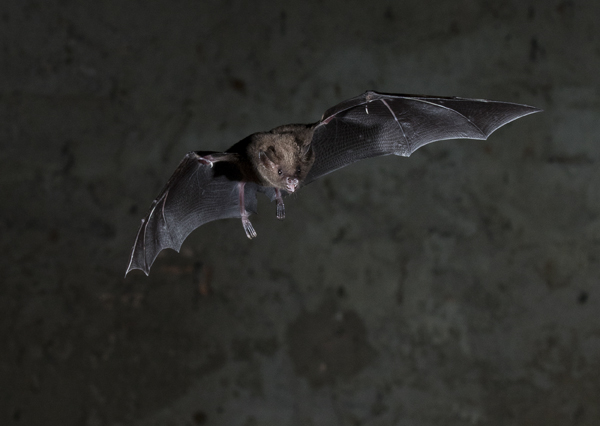
At any rate, the entire afternoon was spent getting ready, cutting, lashing, setting up a dummy run to be sure I wasn’t missing anything, and then driving at 5PM to the bats. I was worried I might flush the bats, so I worked alone, quietly, and the bats remained undisturbed. I managed about 25 shots, and could have done more but my Range IR battery died, and no battery replacement seemed to work and, as I tried, I had my alignment ruined. It was now nearly 7PM, dinner was supposed to be at 7:30, and since I was the only guest, I knew the lodge was planning something special.
I returned home, walked the couple hundred yards to the Sabre camera traps, showered, and met the lodge owners for dinner. Afterwards, using my new light stands, I set up the Range IR as their feeding station, but I got nothing – a Jacare’ Caiman knocked the bamboo lightstands over, misaligning flashes and Range IR.
Day 11. Curasaca to SouthWild – Santa Teresa
My room looked like a bomb had gone off, and equipment and clothes were everywhere, such that finding anything was nearly impossible. I spent the first part of the morning organizing and packing, demonstrating several times the definition of insanity, as I looked and looked in the same spots repeatedly for a missing item, as if I missed it the other ten times, and finally reached in my pants pocket – the only place I hadn’t looked, even once, and I had it on me for hours!
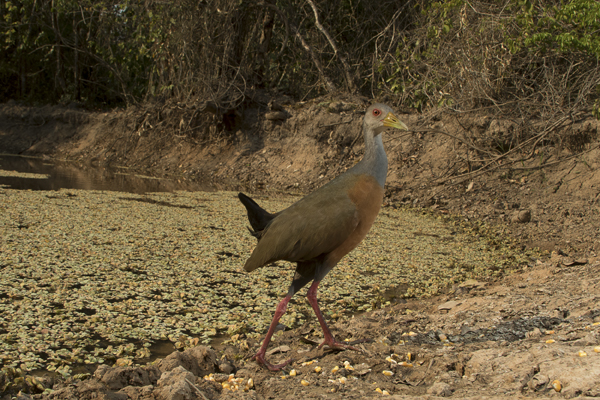
I checked the Sabre’s and although an Agouti was at the waterhole, the image was too small, as I was set up for Tapir. I reset the Sabre beam and camera, hoping now for another Agouti, but only a Gray-necked Wood-Rail came in – although I did get nice shots.
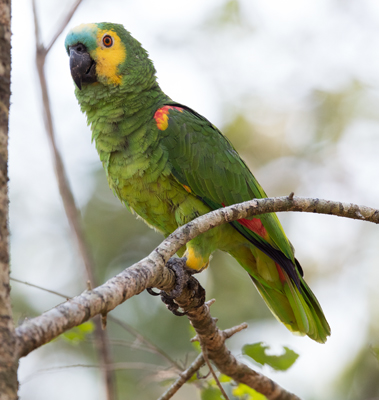 I ate breakfast late – 8:30, and soon after I began eating I had to stop to retrieve my 800, as birds were all around the feeder, including several Turquoise-fronted Amazon parrots. Eating breakfast, while shooting out the ‘shooting window, ‘ I managed some nice shots of the parrots, a dove, and a Purplish Jay. Great Rufous Woodcreepers and Black-fronted Nunbirds are all around my cabin, although not when I had a camera handy, but the area is birdy. By 9:30, despite baiting with grapes and watermelon, the woods suddenly went stone-cold silent, no calls, no flights, dead. I left the dining area to continue packing, retrieving my camera traps, and to finally do some editing!
I ate breakfast late – 8:30, and soon after I began eating I had to stop to retrieve my 800, as birds were all around the feeder, including several Turquoise-fronted Amazon parrots. Eating breakfast, while shooting out the ‘shooting window, ‘ I managed some nice shots of the parrots, a dove, and a Purplish Jay. Great Rufous Woodcreepers and Black-fronted Nunbirds are all around my cabin, although not when I had a camera handy, but the area is birdy. By 9:30, despite baiting with grapes and watermelon, the woods suddenly went stone-cold silent, no calls, no flights, dead. I left the dining area to continue packing, retrieving my camera traps, and to finally do some editing!
At 3PM my group arrived to pick me up for our drive to Santa Teresa … where Trip Two’s report begins.
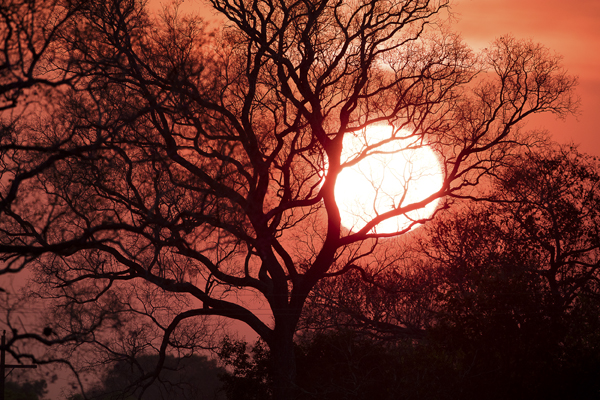
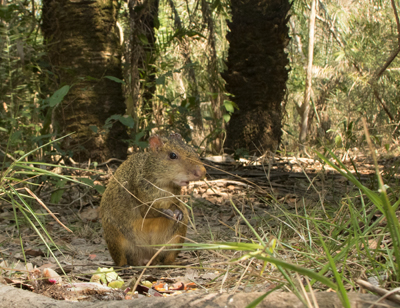 On this trip, I used the new Canon 100-400 which I found to be incredibly sharp, which I used for quick shots, flight shots, and for situations where trying to position my heavier lens on a monopod was impractical. I used a 200-400mm mounted on a Really Right Stuff Monopod and Really Right Stuff Pro Monopod head for the times when I was shooting Jaguars with a bit more time (90% of the jaguar shooting. Those two lenses and two camera bodies easily fit inside my Gura Gear Bataflae bags which I kept in the skiff with me as we motored along looking for Jaguars. Mary used basically the same combination, with the 100-400, and a fixed 500mm f4 lens. In the last two trips, Alaska and this one, we've had one photographer on each using the new Sigma 150-600mm image-stabilization lens, and both loved that lens. I used 64 and 32gb Hoodman Cards. When I was shooting on land I used a Wimberley Gimbal II head, mounted on a Really Right Stuff Tripod. I've used the RRS quick release clamps so that I can, when necessary, change from a Wimberley to a BH40 or BH55 head, and I would highly recommend anyone who plans on using two heads on a trip, like a Wimberley and a BH40 oe BH55, use these plates. Just a couple of pieces are involved, and I've listed the pieces for this below, and I can't stress how convenient this system is for switching heads!
On this trip, I used the new Canon 100-400 which I found to be incredibly sharp, which I used for quick shots, flight shots, and for situations where trying to position my heavier lens on a monopod was impractical. I used a 200-400mm mounted on a Really Right Stuff Monopod and Really Right Stuff Pro Monopod head for the times when I was shooting Jaguars with a bit more time (90% of the jaguar shooting. Those two lenses and two camera bodies easily fit inside my Gura Gear Bataflae bags which I kept in the skiff with me as we motored along looking for Jaguars. Mary used basically the same combination, with the 100-400, and a fixed 500mm f4 lens. In the last two trips, Alaska and this one, we've had one photographer on each using the new Sigma 150-600mm image-stabilization lens, and both loved that lens. I used 64 and 32gb Hoodman Cards. When I was shooting on land I used a Wimberley Gimbal II head, mounted on a Really Right Stuff Tripod. I've used the RRS quick release clamps so that I can, when necessary, change from a Wimberley to a BH40 or BH55 head, and I would highly recommend anyone who plans on using two heads on a trip, like a Wimberley and a BH40 oe BH55, use these plates. Just a couple of pieces are involved, and I've listed the pieces for this below, and I can't stress how convenient this system is for switching heads!
TA-LBC: Round lever-release clamp
Round lever-release style quick-release clamp
TH-DVTL-55: Round Dovetail Plate
Round Dovetail Plate
TH-DVTL-40: Round Dovetail Plate
Round Dovetail Plate
For my remote camera work , I used the RangeIR and the Sabre
camera trigger, and a Really Right Stuff TP-243 Ground 'Pod. I supported my three flashes with 1/4" threaded rods, small ballheads, and Phottix flash slaves, that triggered the flashes from a master mounted on the camera.
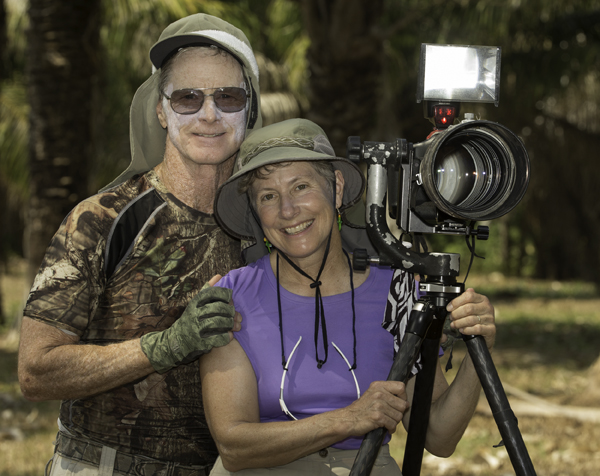
Join us in 2017 -- we'll be doing another trip to the Pantanal!
Check out OUR 2015 Trip Report, or check out all our Trip Reports for the Jaguars and the Pantanal.
Read our 2015 brochure (until I get a chance to update the brochure!) Information applies for 2017, for reference, although exact dates and prices will differ.








Sign up for our Constant Contact Newsletter to receive the latest information on our up coming tours and safaris, immediate opening offerings, and other news. We do not share this list with any other source.
Join us on Facebook at: Follow Hoot Hollow
JAGUARS and the Wildlife
of the Pantanal
Photo Tour
August 2016
Trip ONE Report

While we were concerned about potential crowds and lots of boats in Jaguarland,
we had a strategy ... we had this pair of males
for over an hour -- all by ourselves,
while everyone else was, apparently, jammed up on the main river!
All Photos by Joe McDonald.

On our first afternoon in Jaguarland we had a ten foot long Yellow Anaconda being
harassed by a Sunbittern. The bird displayed often, revealing its wing eyespots.
Day One – Sao Paulo to South Wild Lodge
Perhaps because of the Zika scare our first Pantanal Trip was poorly attended. My good friend Tom, who accompanied me on my very first scouting trip to the Pantanal eight years ago, and another friend, John, who has traveled to Kenya with us, make up our little group. John arrived in Brazil several days earlier to photograph Iguazu Falls, and met us yesterday evening at the Mariot, where we all were staying. This morning John did a graffiti city tour, expected to return at 11AM, but at 12:30, when we were scheduled to head to the airport, no John! Traffic had held him up and his driver was kind enough to wait as John checked out, and delivered him to the airport in plenty of time.
Meanwhile, I searched the airport for a Simms card for my phone, and Tom and I arrived at our gate later than John! We boarded reasonably early, so there was no carry-on space issue, and arrived in Cuiaba around 5PM. Sunset is around 5:40, so our nearly four hour drive to South Wild, our first stop, would be in the dark. Our outfitter screwed up and had a very  small hatchback ready for us, and with the amount of duffles and gear we had it was a tight fit. Our driver was incompetent at packing, so I took over and got us enough space for some degree of comfort. Despite the rather cramped conditions, I still looked forward to that, hoping to see some nocturnal mammals long after dark, but aside from one dubious view of a Javelina, and what may have been a cat but was probably a Crab-eating Fox, we saw nothing but Nightjars. We arrived at the lodge shortly after 9PM, very tired from a long day of travel.
small hatchback ready for us, and with the amount of duffles and gear we had it was a tight fit. Our driver was incompetent at packing, so I took over and got us enough space for some degree of comfort. Despite the rather cramped conditions, I still looked forward to that, hoping to see some nocturnal mammals long after dark, but aside from one dubious view of a Javelina, and what may have been a cat but was probably a Crab-eating Fox, we saw nothing but Nightjars. We arrived at the lodge shortly after 9PM, very tired from a long day of travel.
Day Two – South Wild to Pouso Alegre
Our itinerary is a bad one in the sense that we had to backtrack today, heading back up the Pantaneria Highway, to our next lodge. However, the wildlife there is often much better than at South Wild, and getting two days here would be productive.
 Our morning at South Wild, however, was fantastic. At 7:30AM we took a boat up river to photograph the Black Hawks, Black-collared Hawks, and Ringed Kingfishers that fly in for the fish tossed to them. After having a nice session with a Black Hawk we continued upriver, and found the most cooperative Agami Heron I’ve ever had. This is considered the most beautiful of the New World Herons, and perhaps for the entire world, and normally this stunner frustrates birders and photographers by staying in the deepest cover. This one, this morning, was in shade, but in an open area where a full-frame camera with a 400mm lens was too much lens! We got some great shots.
Our morning at South Wild, however, was fantastic. At 7:30AM we took a boat up river to photograph the Black Hawks, Black-collared Hawks, and Ringed Kingfishers that fly in for the fish tossed to them. After having a nice session with a Black Hawk we continued upriver, and found the most cooperative Agami Heron I’ve ever had. This is considered the most beautiful of the New World Herons, and perhaps for the entire world, and normally this stunner frustrates birders and photographers by staying in the deepest cover. This one, this morning, was in shade, but in an open area where a full-frame camera with a 400mm lens was too much lens! We got some great shots.
 We continued upriver, eventually getting a Black-collared Hawk, but it was the Kingfishers that were the show. We had plenty, and this early in the trip our reflexes and shooting was a bit lacking, but despite this, we all managed some nice keepers. Personally, I missed a lot! I stunk.
We continued upriver, eventually getting a Black-collared Hawk, but it was the Kingfishers that were the show. We had plenty, and this early in the trip our reflexes and shooting was a bit lacking, but despite this, we all managed some nice keepers. Personally, I missed a lot! I stunk.
Continuing upriver we encountered a trio of Giant Otters that we’d seen last year. Now, these otters are completely habituated, and swim to the boats expecting fish. Another boat came up, and one of the otters practically climbed into the boat to get the fish he was dangling. Although we did get nice headshots, I certainly prefer the wild otters we’ll find on the river later on.

After lunch, we packed our duffles in the night game drive truck, and only carried our camera gear in the little car as we made the one hour commute to PA. Driving now in the daylight I could see how incredibly dry the area is for this time of year – virtually no water along the roadsides. Today was hot, and when we arrived at 3PM it was still over 100 degrees. We scheduled our ‘night game drive’ for 4:15, and headed out to a waterhole where we’ve had luck in the past.

We had exceptional luck this evening. A troop of Coatimundis passed, too far away for shots, but while we were distracted and entertained by them a Brazilian Tapir entered the pond. With big ears ringed with a thin white fringe, it was striking, and we managed some decent shots as it plodded across the hyacinth-filled pool. Later, two Crab-eating Foxes groomed each other, and I set up for action, but they never played. Instead, a Giant 
Anteater appeared, with a large baby riding on her back, and eventually the Anteater circled and we shot some great front-on views.
We waited until dusk, and then did a laborious night game drive that yielded nothing until the very end, when I spotted a Lesser Anteater (aka Collared or Lesser Tamandua) with a baby on her back walking near the road. Unfortunately she reacted to the spot light and turned back into the brush, so we were merely treated to a wonderful view, and not to any shots. Still, it was the first time I’d seen a Tamandua with a baby, and to have both species with babies in one afternoon was simply stellar.
We returned to the lodge by 7:15, discovering dinner wouldn’t be served until 7:30, so we had plenty of time to relax (15 minutes!). The internet was sufficient that I could Skype Mary and position the laptop’s camera to show Tom’s computer screen and the anteater photo he was displaying. It was a great day, and I kept on stressing to John how incredibly lucky he was for the first day here. He was really luck in Kenya, too, so it bodes well for us.
Day Three – Pouso Alegre
I was out before sunrise, greeted by a hazy, potentially stormy dawn, with a red fireball rising across the marshes. Somewhere to the east, perhaps the second woodlot over and half mile away, Howler Monkeys heralded the dawn, with their deep, quite unmonkey-like roars. At times the Howlers sounded like ocean waves, a cascading rush of rising and falling notes, at other times choking into gurgling roars. I walked out to look, but with thick brush between us and no monkeys visible as silhouettes in the distant trees, I turned back. Hoping for tapir or marsh deer, I walked out to the elevated boardwalk that spans a now-drying marsh, but aside from some skittish  Limpkins the area was empty. Returning to the lodge’s grounds, I photographed a cooperative pair of Hyacinth Macaws at a natural cavity. At one point another pair flew in, perhaps to steal the nest site, and the birds exploded in squawking. I’ll assume the residents won.
Limpkins the area was empty. Returning to the lodge’s grounds, I photographed a cooperative pair of Hyacinth Macaws at a natural cavity. At one point another pair flew in, perhaps to steal the nest site, and the birds exploded in squawking. I’ll assume the residents won.
Louise, the lodge owner, asked if I’d like to check out some new areas, and I welcomed the chance. We started at a Roseate Spoonbill/Wood Ibis nesting colony. We drove to the site, parked about 200 yards away, and walked across the uneven, lumpy pasture – once  underwater, until we reached a large pool, with the nests in tall trees opposite. A Campo Flicker, Black-collared Hawk, Donocobius songbirds, and Caimans were scattered around the shoreline. The birds were good, and worth revisiting.
underwater, until we reached a large pool, with the nests in tall trees opposite. A Campo Flicker, Black-collared Hawk, Donocobius songbirds, and Caimans were scattered around the shoreline. The birds were good, and worth revisiting.
Leaving the rookery, Tom spotted a Tamandua walking across the open pasture, and headed to a brushy thicket. Knowing we’d lose the anteater there, I grabbed my 800 and tripod, and ran to head the anteater off. I thought I’d block its passage, but the anteater didn’t care and continued walking towards me, far too close for my lens. It stopped only feet away, and I signaled for my driver to take my place and block the anteater while I  ran for a different lens. Whether it just walked on by, or he was a bit afraid, I don’t know, but the anteater went into the brush, and stayed there. John, who was shooting while I was blocking, got some nice shots, and Tom managed a few, too. I did not!
ran for a different lens. Whether it just walked on by, or he was a bit afraid, I don’t know, but the anteater went into the brush, and stayed there. John, who was shooting while I was blocking, got some nice shots, and Tom managed a few, too. I did not!
We continued on to the ‘hide,’ where I looked for the Collared Forest Falcon nest – either unsuccessfully or the nest was empty. A Nunbird perched unafraid nearby as the driver and I walked about, and Hyacinth Macaws squawked overhead. Back at the pond, we cut down some of the annoying weeds that were blocking a clear view of the pond. The entire area had previously been cut, but there were a few that missed a cutting, and these were problematic. Hopefully, no longer.
We finished the morning at a Jabiru Stork nest, with one adult and three half-grown chicks. They did little, and the light was a bit dull.  Shooting some record shots, and ISO comparison shots with the 5D rs, we started back to the lodge – delayed by a good shooting opportunity with a Brocket Deer.
Shooting some record shots, and ISO comparison shots with the 5D rs, we started back to the lodge – delayed by a good shooting opportunity with a Brocket Deer.
After lunch, the somewhat ominous-looking skies grew more threatening, with the northern horizon covered in a gloom of gray, thunder rolling, and a cool breeze. As I write this we may miss the rain, but the afternoon shoot will be a low light situation, to be sure!
PM. The storm missed us. At 2:30, bored, I borrowed a bicycle and rode back to the location where we had the Tamandua, but it was gone. I also explored ‘the jaguar forest,’ where Louise, the lodge owner, was leading a hike when, somewhere above them, a great roar enveloped the forest. They exhibited, without running, but terrified. I saw nothing there today, but in the overcast light of the post-storm skies I wished I had had my wide-angle for landscapes. As it was, I did some with an Olympus 4/3rds, at 80mm.
We left at 4PM, under a clear western sky. The storm had cooled the air, although waiting at the waterhole in the sun it was hot. I sat beneath the truck, in the shade, where I waited until 4:45, then reentered the truck for our last 45 minutes. The same pair of Crab-eating Foxes we had yesterday milled about the area, either giving a plaintive whinny call, or a harsh bark that reminded me of an alarm bark of a Jackal. Most of the time, the two just curled up and slept.
Nothing came to the pond, despite our efforts at gardening it clear, and at 5:30, at dusk, we headed back to the lodge. Earlier, during the storm, we had lost power, and we returned to a lodge in the dark, but by 7 the power was restored. Our driver headed on to Pocone’ after I gave him his tip, and at this point we are without any vehicle for our trip to Porto Joffre tomorrow. Hopefully our outfitter is on top of things, and a vehicle will be here and waiting for us. Tonight, because of the storm, it is pleasant, and sitting out as we were, waiting for the lights to hopefully return, and drinking a liquid dinner (beer), there were no mosquitos. Ironic, since the worry about Zika has depressed tourism this year.

Day Four. Pouso Alegre to Flotel (Jaguar Country)
Our concerns about being marooned without a vehicle were unfounded – a tourist van, with plenty of room, arrived at 7:30AM and shortly after 8AM we headed southeast towards Porto Joffre. The state of the wooden bridges is the worst I’ve ever seen here, and many are now gone, removed completely in preparation for replacing these bridges with steel structures. Some are already in place, and operable, but others are gone, and dirt trails circle the site of the old bridges. The rainy season starts by December, and I wonder if the missing bridges will be replaced by the beginning of the rains. Could be interesting.
We arrived at Porto Joffre shortly after 11, record time, including a stop for the Great Horned Owl area, where we saw two full grown but fluffy babies. We didn’t bother photographing the birds, high in the trees and backlighted, and drove on, recording Snail Kites and Southern Screamers. We were met at the dock by one of my favorite boatmen, John, who will be our boatman for the entire tour.
 At lunch, our outfitter rushed in to tell us that a big male Jaguar had been spotted 20 minutes up river, and he was sending a boat up to see if it was still there. He suggested we be ready in twenty minutes just in case, but we left anyway, early, and headed up river. Meanwhile, en route, our outfitter was returning, informing us that the Jaguar had left. My boatman decided to continue – a course I’d have suggested if he didn’t, and we found the Jaguar! She (it was a female) was standing beneath a brushy deadfall, then sat and laid down, as we photographed. Later, she rose and disappeared, but our boatman kept up with her, actually surprising me because he’d motor much further upriver than I thought the cat would travel, but within minutes she was where we waited. We stayed with her for about a mile of river, and had several shooting ops, with no one else around. A great way for John to be introduced to the Pantanal and Jaguar Country!
At lunch, our outfitter rushed in to tell us that a big male Jaguar had been spotted 20 minutes up river, and he was sending a boat up to see if it was still there. He suggested we be ready in twenty minutes just in case, but we left anyway, early, and headed up river. Meanwhile, en route, our outfitter was returning, informing us that the Jaguar had left. My boatman decided to continue – a course I’d have suggested if he didn’t, and we found the Jaguar! She (it was a female) was standing beneath a brushy deadfall, then sat and laid down, as we photographed. Later, she rose and disappeared, but our boatman kept up with her, actually surprising me because he’d motor much further upriver than I thought the cat would travel, but within minutes she was where we waited. We stayed with her for about a mile of river, and had several shooting ops, with no one else around. A great way for John to be introduced to the Pantanal and Jaguar Country!
Now about 3PM, we headed back towards the main river, stopping a short time later for a family of Giant Otters. We had followed them for only a short distance when we received a radio call that an Anaconda had been spotted, just upriver from where we were. We raced to the site, finding a  Sunbittern in full display, circling and pestering the oblivious Yellow Anaconda. The shooting was fast and furious, and I thought I screwed up most of the shots (turned out, I didn’t), and eventually the snake went into the water and swam off. But it returned to shore, where we left it, with the Sunbittern apparently harassing, or looking for, another Anaconda that had been with the first. I’m thinking the one we saw was a female (they are big) and the second a male, chasing her for mating. Another boat saw the second one – we did not.
Sunbittern in full display, circling and pestering the oblivious Yellow Anaconda. The shooting was fast and furious, and I thought I screwed up most of the shots (turned out, I didn’t), and eventually the snake went into the water and swam off. But it returned to shore, where we left it, with the Sunbittern apparently harassing, or looking for, another Anaconda that had been with the first. I’m thinking the one we saw was a female (they are big) and the second a male, chasing her for mating. Another boat saw the second one – we did not.

We started motoring back to the main river but I turned around and saw that the Sunbittern was now running up the river’s edge, and I was sure it was going to start harassing the Anaconda again. We turned, and this time positioned ourselves with the sun full to our backs, for great directional light, as the bird spread its wings and postured, as the snake slowly crept by. Sunbitterns are distinctive in that they have two false eyespots on their wings, displayed by the bird fanning its wings out. At a nest, the bird will face an intruder, fan its wings to display the eyes, and fold the wing edges forward, so that the bird and its fake eyes are both aimed at the threat. For predators, like hawks and this snake, the bird simply raised its wings, and we only had eyespot views from behind – the bird didn’t fold its wings forward. Still, it was an incredible show and something I’ve never seen before.
We continued on, hearing about another Jaguar in the main river. When we arrived about 20 boats were dispersing – people did get shots, but apparently it was a hectic scene. We continued upriver, almost reaching the great sandbar when we were radioed again – the Jaguar had returned. We raced down, but missed it, and continued down river to the Black Lagoon where we explored for a short time. The light was failing, and we had had a great day, and while we still had light to travel by we headed home.
Day Five. Jaguarland
We had breakfast at 6AM to be ready for a 6:30 departure under a sky that was slightly overcast and threatened bad weather later in the day. That, however, did not happen, although for much of the morning there was some overcast, so the weather, and conditions, were great.

We headed up to the Three Brothers area, exploring the Black Lagoon, Charles Creek, and, finally, a tributary that led to the Cuiaba River. On the main river we encountered six Giant Otters that appeared to be headed back to their den. We followed them, down river, for at least two miles, where they turned up the Cuiaba and eventually settled at a deadfall where their den was. How’d I know this? At this time of day otters generally commute home, but more telling, these otters did not bother to fish. Only twice, in two or three miles, did they catch any fish, whereas, in a normal hunting foray, they’d have a fish every few minutes.

We spent about an hour with a family of Capybaras, three adults and two babies, and although the babies finally woke up, they didn’t play, and the shooting was rather tame. We headed onward, reaching the Cuiaba River where we photographed Jacare’ Caimans with their mouths gaping wide, where we also received a radio call that a Jaguar had been seen. It took us 40 minutes to arrive, on another tributary of the Three Brothers, where the mother Jaguar and nearly full-grown cub gave us tantalizing glimpses through the brush and trees. At 12:10 I decided the wait wasn’t worth it, and we headed back for lunch. All the other boats soon joined us.
PM. We were headed back towards the mother when another boatman signaled to us that a Jaguar on the main river was crossing towards the Black Lagoon.

We did a U-turn and headed that way, and were in a prime position when the female Jaguar finally appeared. During the next hour we photographed
her as she unsuccessfully charged a Caiman, did a lengthy flehmen display where a male (presumably) had scent marked earlier – sometimes just 25 feet away, and where, when the Jaguar moved from deep shade to the open edge of the marsh, I forgot to change exposures! I  shot 20 shots before I realized I was off, then corrected myself (the image on left). I’d been off by 2 stops, but in the RAW converter I brought back the shots, and all was not lost.
shot 20 shots before I realized I was off, then corrected myself (the image on left). I’d been off by 2 stops, but in the RAW converter I brought back the shots, and all was not lost.
Eventually the Jaguar moved back into the interior, and we doubled back to the Charles Creek where we waited nearly an hour, expecting her to return. She did not. We returned to the main river, heading to the mother and cub, but the day was drawing to a close and some of the Flotel’s other boats were just returning from there, unsuccessfully, so we headed back to home. It was, however, a spectacular afternoon of Jaguar shooting.

Day Six. Jaguarland
A thunderstorm and soaking rain during the night ushered in an Antarctic Cold Front. The day started gloomy with a threat of serious rain, and cold. How cold? I’m a wimp and I like to be warm, so I was wearing long pants and rain pants, a T-shirt, light long sleeve shirt, a medium weight vest, a light weight down jacket, and a rain jacket on top. A wool cap under my floppy ball cap, and sun gloves completed the outfit. During the morning we had a few light sprinkles, but as the morning progressed the skies cleared, although the wind that was present all morning persisted through the day.
 The day started slow, but that was fine as we’ve had plenty of Jaguars and we were happy to attempt to photograph baby Capybaras playing – they quit soon after we’d start. We had a great Crane Hawk, the South American ecological equivalent to the Gymnogene or African Harrier Hawk. This one hung from thin vines dangling to the river, groping about in the thicker areas, probably searching for frogs. We traveled far up the Three Brothers river, and upon our return encountered multiple boats staked out at a Jaguar and cubs. We eventually saw the mother and one cub, but there were no photos, the vegetation was thick, and we decided to leave the crowds and go to lunch.
The day started slow, but that was fine as we’ve had plenty of Jaguars and we were happy to attempt to photograph baby Capybaras playing – they quit soon after we’d start. We had a great Crane Hawk, the South American ecological equivalent to the Gymnogene or African Harrier Hawk. This one hung from thin vines dangling to the river, groping about in the thicker areas, probably searching for frogs. We traveled far up the Three Brothers river, and upon our return encountered multiple boats staked out at a Jaguar and cubs. We eventually saw the mother and one cub, but there were no photos, the vegetation was thick, and we decided to leave the crowds and go to lunch.
 Along the way we received a radio call that another Jaguar had been spotted south on the Cuiaba River. We headed there just in time to see the cat disappear, but within ten minutes it reappeared and performed nicely. At one point it ran across one log, ducked into cover, and jumped on a large tree trunk stuck in the river – close to the dream shot I’ve wanted. Eventually the cat settled down and appeared to be going to sleep, so we headed back to lunch, arriving at 1PM.
Along the way we received a radio call that another Jaguar had been spotted south on the Cuiaba River. We headed there just in time to see the cat disappear, but within ten minutes it reappeared and performed nicely. At one point it ran across one log, ducked into cover, and jumped on a large tree trunk stuck in the river – close to the dream shot I’ve wanted. Eventually the cat settled down and appeared to be going to sleep, so we headed back to lunch, arriving at 1PM.
PM. We left at 2PM, heading back down the Cuiaba River to check that Jaguar. My boatman spotted another Jaguar about a half mile before we reached the morning’s Jaguar, and we had a great show, all to ourselves, until the mob, flotilla, horde of boats our boatman called in arrived. Prior to that, we had one great sequence where the Jaguar dove into the water after a Capybara, missed, got out, ran a few yards, and dove in again for another. I anticipated the second leap but it happened so fast – out of nowhere so I could not be set on a location – and all I caught was a great splash.
 Perhaps attracted to the splash a Giant Otter appeared, barking a rattle, and the Jaguar, still in the water, quickly dashed to shore. The cat moved about twenty feet up the bank where it turned and watched the otter, who rose high in the water, chattering with annoyance, as if daring the Jaguar to enter its realm. The cat did not, and the otter finally swam off. Our boatman radioed downriver to the other boats, and soon our show would be over.
Perhaps attracted to the splash a Giant Otter appeared, barking a rattle, and the Jaguar, still in the water, quickly dashed to shore. The cat moved about twenty feet up the bank where it turned and watched the otter, who rose high in the water, chattering with annoyance, as if daring the Jaguar to enter its realm. The cat did not, and the otter finally swam off. Our boatman radioed downriver to the other boats, and soon our show would be over.
Eventually about 20 boats arrived, and when our Jaguar finally disappeared all of the boats headed downriver for the other cat. We did not, and quite content with the shooting we just had, we headed upriver to shoot whatever we would find.
Exploring Charles River, the Black Lagoon, and the site of the mother and cub from this morning, we filmed Black Hawk, Limpkin, Tropical Kingbird, and White-necked Herons. As we were heading back out of the Black Lagoon we received a call that another Jaguar was spotted, right at the mouth of the Lagoon. She was lying in the grasses, supposedly hunting but surely resting to me, but we finished the day with our boat anchored securely in the reeds, photographing this cat in the last light. In total, we saw 5 different Jaguars today, for a total now of 12. And we missed two, by arriving too late!

Day Six. Jaguarland.

Two more Jaguars this morning, and we discovered that yesterday AM’s shoot had two Jaguars – as originally reported, and then confirmed by the Jaguar naturalist on board. This morning, in very cold weather with clear skies, we motored up the Cuiaba River for 1.5 hours until we reached the cross-over stream to the Three Brothers. We had several birds en route, but  upon reaching the Three Brothers, and heading upstream, we had a male Jaguar with fresh scars on his snout. The cat was shy, and after laying down behind a bush it rose and walked off. Several times, while out of sight, the cat roared, an ‘uhh – oommm’ much like a tiger’s roar, or territorial announcement.
upon reaching the Three Brothers, and heading upstream, we had a male Jaguar with fresh scars on his snout. The cat was shy, and after laying down behind a bush it rose and walked off. Several times, while out of sight, the cat roared, an ‘uhh – oommm’ much like a tiger’s roar, or territorial announcement.
At the Charles River we had an Ocelot – the first I’ve had on the river. I managed a quick burst of 7, with 3 having the cat’s head clear, and sharp! We continued, and near the confluence of the Piquiri, we had another female Jaguar. She was hunting along the high bank, and downstream a family of Capybaras were on shore. We set up there, waiting and ready, but the rodents sensed her and dashed to the water. We did not see the cat again. We returned to the boat at 1.

PM. We headed out at 2PM, and our Jaguar from this morning was still hunting. There was an entire flotilla of boats there, and at one point my boatman crossed a photographer’s line of sight. The photographer specializes on big cats, shoots at times for Nat’l Geo, and is a guy I’ve heard mixed comments about. At any rate, when we crossed in front of him the Jaguar was still in the reeds and out of sight, but appeared as we crossed. Mind you, the shot was no different than the dozens of other opportunities we had, but the guy then yelled to our boatman, ‘you do that again and I’ll cut your gas line.’ Which my boatman paid no heed. As we passed, I had actually ducked down low just in case we’d be in a shot, but another pro photographer, who I spoke with this evening, said that this guy is a real prima donna and stands in front of people whenever he wishes to. There are two sects of rules. Ironically, later this Jaguar crossed the river, and this guy was the one boat to zoom in, cutting across the path of every other boat, and positioning himself to be in front of the jaguar as it swam. Two rules.

Once the Jaguar crossed, it was on the shaded side of the river and, fed up with the crowds, we headed up the Three Brothers River to see what we could see. As we motored, we received a radio call that another Jaguar was spotted on the Cuiaba River, and I was asked if we should go. Since all the other boats were there, I said no, we’d continue, and shoot whatever.
Cruising along, we photographed an immature Black-crowned Night Heron on the Charles River, then continued upriver towards the big sandbar. Meanwhile, the Jaguar on the Cuiaba made a kill, but the only shots were those as it carried off the kill (a caiman). For us, we found another Jaguar, lying beneath a bush behind a large sandbar. My boatman said he spotted another, and so we waited, and about 30 minutes later the two cats  emerged. First, they only poked their heads above the sandbar, but we were quiet, and as time passed the two cats got up, nuzzled one another, mutually groomed, and posed innumerable times – two adult males that must be brothers, and a spectacular show that lasted over an hour. One other boat was there when we arrived, but that boat moved on, and for the entire show we were the only ones there. We were quiet, patient, and man, did we get the shots! It was spectacular, and at 5:25 we headed back to the Flotel for the evening!
emerged. First, they only poked their heads above the sandbar, but we were quiet, and as time passed the two cats got up, nuzzled one another, mutually groomed, and posed innumerable times – two adult males that must be brothers, and a spectacular show that lasted over an hour. One other boat was there when we arrived, but that boat moved on, and for the entire show we were the only ones there. We were quiet, patient, and man, did we get the shots! It was spectacular, and at 5:25 we headed back to the Flotel for the evening!
Day Seven. Jaguarland
Today was a slow day. It was even colder this morning, with mists rising in thick clouds from the river, but we missed the best light for morning mist. We headed up the Three Brothers, stopping for a Howler Monkey, Plumbeous Ibis, and my first-ever view of a Greater Ani, a huge bird, almost half a meter in length. Quite distinctive, with a purple green color and erect posture, but it flew off before I could get a shot. We arrived at the crossing point of the Cuiaba where we had a radio call that a Jaguar had been  spotted about 10 minutes down the Cuiaba river. We turned around and went for it, but the Jag was gone by the time we arrived. We continued downriver, and soon had another call that a Jag was spotted on the Black Lagoon. We headed there, and I had a distant view, but that was it. At lunch, six Giant Otters visited the boat, with one actually coming onboard to beg for fish. The crew caught a couple of eel-like minnows, which the otter ate, grabbing the fish each time and diving back into the river to feed.
spotted about 10 minutes down the Cuiaba river. We turned around and went for it, but the Jag was gone by the time we arrived. We continued downriver, and soon had another call that a Jag was spotted on the Black Lagoon. We headed there, and I had a distant view, but that was it. At lunch, six Giant Otters visited the boat, with one actually coming onboard to beg for fish. The crew caught a couple of eel-like minnows, which the otter ate, grabbing the fish each time and diving back into the river to feed.
 PM. At 2 we headed back up the Cuiaba for a 1.75 motor to the crossing point, stopping enroute for a Southern Screamer, which did not cooperate, and some muddy Capybaras. It was nearly 4PM when we reached the Three Brothers River, where we were just minutes too late for a glimpse of a shy Jaguar – perhaps the same shy male we had in that general area yesterday. We arrived back at the Flotel at 5:45 – as the air began to cool. Our butts were sore from all the sitting and no shooting!
PM. At 2 we headed back up the Cuiaba for a 1.75 motor to the crossing point, stopping enroute for a Southern Screamer, which did not cooperate, and some muddy Capybaras. It was nearly 4PM when we reached the Three Brothers River, where we were just minutes too late for a glimpse of a shy Jaguar – perhaps the same shy male we had in that general area yesterday. We arrived back at the Flotel at 5:45 – as the air began to cool. Our butts were sore from all the sitting and no shooting!
Day Eight. Jaguarland to Santa Teresa
We had a final run on the river, leaving in what was still a pleasantly cool/cold morning with silver mist rising from the warm river water. We heard of one report of a Jaguar on the Cuiaba, but we passed, continuing on  the Three Brothers and the various side channels. Ironically, as we completed the run, and were hoping to have an early departure from the Flotel to the mainland, we passed by Charles Creek and went a short distance up the Black Lagoon. About a half hour after we skipped the Charles Creek McJaguar, the one-eyed male that was a star the last few years, was seen on the beach at this creek, and probably visible from the main river. I wonder if we had explored that short water system if we’d have had him further upstream? It would have been nice to finish with this famous cat, but for those that did have him, it ended up to be somewhat of a nightmare. Apparently almost every boat on the river was jammed in this little creek, making for a real mess. I did not want to end my experience on the river in that way, so perhaps we were lucky.
the Three Brothers and the various side channels. Ironically, as we completed the run, and were hoping to have an early departure from the Flotel to the mainland, we passed by Charles Creek and went a short distance up the Black Lagoon. About a half hour after we skipped the Charles Creek McJaguar, the one-eyed male that was a star the last few years, was seen on the beach at this creek, and probably visible from the main river. I wonder if we had explored that short water system if we’d have had him further upstream? It would have been nice to finish with this famous cat, but for those that did have him, it ended up to be somewhat of a nightmare. Apparently almost every boat on the river was jammed in this little creek, making for a real mess. I did not want to end my experience on the river in that way, so perhaps we were lucky.

Our day was a good one, with at least nine species photographed by everyone, and 10 for some. The subjects included Rufescent Tiger-Heron, White-necked Heron, Boat-billed heron, Sungrebe (a real rarity), Giant 
Otter – on a sand bank, Two species of Swallows, Roadside Hawk, Black-backed Marsh Tyrant, and Southern Screamer – perched high on a tree and flapping its wings, exposing the formidable spur on the elbow of its wings. Today was the first time this trip that we had an opportunity to photograph the ‘bubble dance’ of Caimans, where they vibrate the water into a fountain – probably as a courtship attractant.

We hoped to leave early for the mainland but the terrible conditions of the bridges apparently held up our driver, and so we met her at 1:30, after only a 15 minute boatride downriver. The lady drove fast, and we arrived at the SouthWild lodge at 3:30. At 4:15, Tom and I went into the forest where I positioned 7 flashes for the Ocelot shoot that evening. The lighting was perfect.

At 5:15 we headed to the forest, as we were told that the Ocelot sometimes arrives early. Two species of Shrike and Ant-shrike stole chicken pieces from the feeder – my lighting made for nice portraits, but no Ocelot ever arrived! We waited until 8:15, took down the flashes, and returned to the lodge by 8:30, to discover the food was put away. The manager prepared a more than filling plate for us, so we did have dinner. It was a disappointment not to get the Ocelot, although I do have the lighting worked out for the next trip – a bit too late for Tom and John!
Day Nine – Santa Teresa

Packing until late, I tried sleeping in to 6, although the Chachalacas woke me up earlier with their pre-dawn screeching. At 7:30 we did another boat ride for the hawks and kingfishers, and our boatman, the younger of the guys normally doing this, actually understood light and positioning, and we had our best run in a long time with him. We had two opportunities with Black-collared hawks, one with Greater Black Hawks, and probably a dozen times with Ringed Kingfishers. (Note: How easy it is to forget! In reviewing the images later, we had 33 chances at Kingfishers diving in for fish – not 12!). An Amazon Kingfisher is so tame it lands on the boat, waiting for fish, and at the end of the run the same bird landed on a paddle raised in the air, and then at the boat front, where it rode with us about a quarter mile.
The cold front is passed, and the morning, by 9:30, was hot! We spent the rest of the morning editing and catching up on work, and for Tom and John, packing for home.




In the afternoon we headed for our lst stop, one of my favorite lodges, Curasaca, which will be an easy departure point for Tom and John’s trip to Cuiaba tomorrow. I set up a Range IR camera trap about a quarter mile into  the forest on a game trail. I’d probably have done better putting the trap 50 yards into the forest, as game continually comes in to feed at their feeders, but I was hoping for a Tapir. At any rate, between scouting and setting up and then arming the traps I put a few miles in, back and forth. The rest of our evening was spent recounting the highlights of the trip – and for Tom and I it was getting away from the crowds and having parts of the rivers all to ourselves, like in the old days, as well as our usual highlights of the two jaguars together, the Agami Heron, infra images, and so much more.
the forest on a game trail. I’d probably have done better putting the trap 50 yards into the forest, as game continually comes in to feed at their feeders, but I was hoping for a Tapir. At any rate, between scouting and setting up and then arming the traps I put a few miles in, back and forth. The rest of our evening was spent recounting the highlights of the trip – and for Tom and I it was getting away from the crowds and having parts of the rivers all to ourselves, like in the old days, as well as our usual highlights of the two jaguars together, the Agami Heron, infra images, and so much more.




Day 10. Curicaca
Today, August 26th, was my birthday, and I had the vaguest plans to actually relax, edit, and recharge for the next group. It didn’t happen – not by a long shot.
I started the day by seeing off John and Tom, and then checking my camera trap. Nothing hit it, so I rearmed the trap with fresh batteries and repositioned the Range IR a bit differently, and let it go for the morning. I got some nice shots of Agoutis, flashed but balanced with the natural light.
Next, as I promised Mary, I did some video, with me talking into the camera at different angles about what the Pantanal has to offer. Doing so, I passed on the innumerable bird shooting opportunities I had. Later, I borrowed a bicycle from the lodge, and biked the two miles to the main road, and explored several locations around the area for shooting opps. I  found a roost of bats – all nectar feeders (Pallas’s, perhaps) and unequipped with light stands I spent much of the rest of the day MacGyver-ing make-shift light stands out of bamboo. This required borrowing a hacksaw, and then lashing the pieces together, with a center pole for the 1/4x20 rods to hold the flashes. I hoped to borrow the lodge’s vehicle but it was in Cuiaba, so I had the owner call around and for $50 US two teen-agers from Pocone’ drove down to drive me and all the gear to the bats in the late afternoon.
found a roost of bats – all nectar feeders (Pallas’s, perhaps) and unequipped with light stands I spent much of the rest of the day MacGyver-ing make-shift light stands out of bamboo. This required borrowing a hacksaw, and then lashing the pieces together, with a center pole for the 1/4x20 rods to hold the flashes. I hoped to borrow the lodge’s vehicle but it was in Cuiaba, so I had the owner call around and for $50 US two teen-agers from Pocone’ drove down to drive me and all the gear to the bats in the late afternoon.
Because of an unusually hectic schedule before this trip, we didn’t finish packing until an hour before I left for Brazil. Consequently, Mary and I found I was over-weight with one bag, so I dumped equipment – and some proved vital. Fortunately, Tom offered to leave his flashes, rods, and – most importantly, Phottix Stratos II transmitter/receivers. I almost passed on those, as I forgot that to shoot Bulb with flash – where the Range IR trips the flashes, only the Stratos work. The Ares, which I used for on-camera tripping, has no provision for a hot-shoe tripping – although I’m going to look into that!
Prior to leaving for the bats I set up two other Camera Traps, using Cognisys Sabres, at a nearby waterhole where I hoped to get a Tapir. I left it unarmed until I’d return from the bats.

At any rate, the entire afternoon was spent getting ready, cutting, lashing, setting up a dummy run to be sure I wasn’t missing anything, and then driving at 5PM to the bats. I was worried I might flush the bats, so I worked alone, quietly, and the bats remained undisturbed. I managed about 25 shots, and could have done more but my Range IR battery died, and no battery replacement seemed to work and, as I tried, I had my alignment ruined. It was now nearly 7PM, dinner was supposed to be at 7:30, and since I was the only guest, I knew the lodge was planning something special.
I returned home, walked the couple hundred yards to the Sabre camera traps, showered, and met the lodge owners for dinner. Afterwards, using my new light stands, I set up the Range IR as their feeding station, but I got nothing – a Jacare’ Caiman knocked the bamboo lightstands over, misaligning flashes and Range IR.
Day 11. Curasaca to SouthWild – Santa Teresa
My room looked like a bomb had gone off, and equipment and clothes were everywhere, such that finding anything was nearly impossible. I spent the first part of the morning organizing and packing, demonstrating several times the definition of insanity, as I looked and looked in the same spots repeatedly for a missing item, as if I missed it the other ten times, and finally reached in my pants pocket – the only place I hadn’t looked, even once, and I had it on me for hours!

I checked the Sabre’s and although an Agouti was at the waterhole, the image was too small, as I was set up for Tapir. I reset the Sabre beam and camera, hoping now for another Agouti, but only a Gray-necked Wood-Rail came in – although I did get nice shots.
 I ate breakfast late – 8:30, and soon after I began eating I had to stop to retrieve my 800, as birds were all around the feeder, including several Turquoise-fronted Amazon parrots. Eating breakfast, while shooting out the ‘shooting window, ‘ I managed some nice shots of the parrots, a dove, and a Purplish Jay. Great Rufous Woodcreepers and Black-fronted Nunbirds are all around my cabin, although not when I had a camera handy, but the area is birdy. By 9:30, despite baiting with grapes and watermelon, the woods suddenly went stone-cold silent, no calls, no flights, dead. I left the dining area to continue packing, retrieving my camera traps, and to finally do some editing!
I ate breakfast late – 8:30, and soon after I began eating I had to stop to retrieve my 800, as birds were all around the feeder, including several Turquoise-fronted Amazon parrots. Eating breakfast, while shooting out the ‘shooting window, ‘ I managed some nice shots of the parrots, a dove, and a Purplish Jay. Great Rufous Woodcreepers and Black-fronted Nunbirds are all around my cabin, although not when I had a camera handy, but the area is birdy. By 9:30, despite baiting with grapes and watermelon, the woods suddenly went stone-cold silent, no calls, no flights, dead. I left the dining area to continue packing, retrieving my camera traps, and to finally do some editing!
At 3PM my group arrived to pick me up for our drive to Santa Teresa … where Trip Two’s report begins.

 On this trip, I used the new Canon 100-400 which I found to be incredibly sharp, which I used for quick shots, flight shots, and for situations where trying to position my heavier lens on a monopod was impractical. I used a 200-400mm mounted on a Really Right Stuff Monopod and Really Right Stuff Pro Monopod head for the times when I was shooting Jaguars with a bit more time (90% of the jaguar shooting. Those two lenses and two camera bodies easily fit inside my Gura Gear Bataflae bags which I kept in the skiff with me as we motored along looking for Jaguars. Mary used basically the same combination, with the 100-400, and a fixed 500mm f4 lens. In the last two trips, Alaska and this one, we've had one photographer on each using the new Sigma 150-600mm image-stabilization lens, and both loved that lens. I used 64 and 32gb Hoodman Cards. When I was shooting on land I used a Wimberley Gimbal II head, mounted on a Really Right Stuff Tripod. I've used the RRS quick release clamps so that I can, when necessary, change from a Wimberley to a BH40 or BH55 head, and I would highly recommend anyone who plans on using two heads on a trip, like a Wimberley and a BH40 oe BH55, use these plates. Just a couple of pieces are involved, and I've listed the pieces for this below, and I can't stress how convenient this system is for switching heads!
On this trip, I used the new Canon 100-400 which I found to be incredibly sharp, which I used for quick shots, flight shots, and for situations where trying to position my heavier lens on a monopod was impractical. I used a 200-400mm mounted on a Really Right Stuff Monopod and Really Right Stuff Pro Monopod head for the times when I was shooting Jaguars with a bit more time (90% of the jaguar shooting. Those two lenses and two camera bodies easily fit inside my Gura Gear Bataflae bags which I kept in the skiff with me as we motored along looking for Jaguars. Mary used basically the same combination, with the 100-400, and a fixed 500mm f4 lens. In the last two trips, Alaska and this one, we've had one photographer on each using the new Sigma 150-600mm image-stabilization lens, and both loved that lens. I used 64 and 32gb Hoodman Cards. When I was shooting on land I used a Wimberley Gimbal II head, mounted on a Really Right Stuff Tripod. I've used the RRS quick release clamps so that I can, when necessary, change from a Wimberley to a BH40 or BH55 head, and I would highly recommend anyone who plans on using two heads on a trip, like a Wimberley and a BH40 oe BH55, use these plates. Just a couple of pieces are involved, and I've listed the pieces for this below, and I can't stress how convenient this system is for switching heads!
TA-LBC: Round lever-release clamp
Round lever-release style quick-release clamp
TH-DVTL-55: Round Dovetail Plate
Round Dovetail Plate
TH-DVTL-40: Round Dovetail Plate
Round Dovetail Plate
For my remote camera work , I used the RangeIR and the Sabre
camera trigger, and a Really Right Stuff TP-243 Ground 'Pod. I supported my three flashes with 1/4" threaded rods, small ballheads, and Phottix flash slaves, that triggered the flashes from a master mounted on the camera.

Join us in 2017 -- we'll be doing another trip to the Pantanal!
Check out OUR 2015 Trip Report, or check out all our Trip Reports for the Jaguars and the Pantanal.
Read our 2015 brochure (until I get a chance to update the brochure!) Information applies for 2017, for reference, although exact dates and prices will differ.








Sign up for our Constant Contact Newsletter to receive the latest information on our up coming tours and safaris, immediate opening offerings, and other news. We do not share this list with any other source.
Join us on Facebook at: Follow Hoot Hollow
JAGUARS and the Wildlife
of the Pantanal
Photo Tour
August 2016
Trip ONE Report

While we were concerned about potential crowds and lots of boats in Jaguarland,
we had a strategy ... we had this pair of males
for over an hour -- all by ourselves,
while everyone else was, apparently, jammed up on the main river!
All Photos by Joe McDonald.

On our first afternoon in Jaguarland we had a ten foot long Yellow Anaconda being
harassed by a Sunbittern. The bird displayed often, revealing its wing eyespots.
Day One – Sao Paulo to South Wild Lodge
Perhaps because of the Zika scare our first Pantanal Trip was poorly attended. My good friend Tom, who accompanied me on my very first scouting trip to the Pantanal eight years ago, and another friend, John, who has traveled to Kenya with us, make up our little group. John arrived in Brazil several days earlier to photograph Iguazu Falls, and met us yesterday evening at the Mariot, where we all were staying. This morning John did a graffiti city tour, expected to return at 11AM, but at 12:30, when we were scheduled to head to the airport, no John! Traffic had held him up and his driver was kind enough to wait as John checked out, and delivered him to the airport in plenty of time.
Meanwhile, I searched the airport for a Simms card for my phone, and Tom and I arrived at our gate later than John! We boarded reasonably early, so there was no carry-on space issue, and arrived in Cuiaba around 5PM. Sunset is around 5:40, so our nearly four hour drive to South Wild, our first stop, would be in the dark. Our outfitter screwed up and had a very  small hatchback ready for us, and with the amount of duffles and gear we had it was a tight fit. Our driver was incompetent at packing, so I took over and got us enough space for some degree of comfort. Despite the rather cramped conditions, I still looked forward to that, hoping to see some nocturnal mammals long after dark, but aside from one dubious view of a Javelina, and what may have been a cat but was probably a Crab-eating Fox, we saw nothing but Nightjars. We arrived at the lodge shortly after 9PM, very tired from a long day of travel.
small hatchback ready for us, and with the amount of duffles and gear we had it was a tight fit. Our driver was incompetent at packing, so I took over and got us enough space for some degree of comfort. Despite the rather cramped conditions, I still looked forward to that, hoping to see some nocturnal mammals long after dark, but aside from one dubious view of a Javelina, and what may have been a cat but was probably a Crab-eating Fox, we saw nothing but Nightjars. We arrived at the lodge shortly after 9PM, very tired from a long day of travel.
Day Two – South Wild to Pouso Alegre
Our itinerary is a bad one in the sense that we had to backtrack today, heading back up the Pantaneria Highway, to our next lodge. However, the wildlife there is often much better than at South Wild, and getting two days here would be productive.
 Our morning at South Wild, however, was fantastic. At 7:30AM we took a boat up river to photograph the Black Hawks, Black-collared Hawks, and Ringed Kingfishers that fly in for the fish tossed to them. After having a nice session with a Black Hawk we continued upriver, and found the most cooperative Agami Heron I’ve ever had. This is considered the most beautiful of the New World Herons, and perhaps for the entire world, and normally this stunner frustrates birders and photographers by staying in the deepest cover. This one, this morning, was in shade, but in an open area where a full-frame camera with a 400mm lens was too much lens! We got some great shots.
Our morning at South Wild, however, was fantastic. At 7:30AM we took a boat up river to photograph the Black Hawks, Black-collared Hawks, and Ringed Kingfishers that fly in for the fish tossed to them. After having a nice session with a Black Hawk we continued upriver, and found the most cooperative Agami Heron I’ve ever had. This is considered the most beautiful of the New World Herons, and perhaps for the entire world, and normally this stunner frustrates birders and photographers by staying in the deepest cover. This one, this morning, was in shade, but in an open area where a full-frame camera with a 400mm lens was too much lens! We got some great shots.
 We continued upriver, eventually getting a Black-collared Hawk, but it was the Kingfishers that were the show. We had plenty, and this early in the trip our reflexes and shooting was a bit lacking, but despite this, we all managed some nice keepers. Personally, I missed a lot! I stunk.
We continued upriver, eventually getting a Black-collared Hawk, but it was the Kingfishers that were the show. We had plenty, and this early in the trip our reflexes and shooting was a bit lacking, but despite this, we all managed some nice keepers. Personally, I missed a lot! I stunk.
Continuing upriver we encountered a trio of Giant Otters that we’d seen last year. Now, these otters are completely habituated, and swim to the boats expecting fish. Another boat came up, and one of the otters practically climbed into the boat to get the fish he was dangling. Although we did get nice headshots, I certainly prefer the wild otters we’ll find on the river later on.

After lunch, we packed our duffles in the night game drive truck, and only carried our camera gear in the little car as we made the one hour commute to PA. Driving now in the daylight I could see how incredibly dry the area is for this time of year – virtually no water along the roadsides. Today was hot, and when we arrived at 3PM it was still over 100 degrees. We scheduled our ‘night game drive’ for 4:15, and headed out to a waterhole where we’ve had luck in the past.

We had exceptional luck this evening. A troop of Coatimundis passed, too far away for shots, but while we were distracted and entertained by them a Brazilian Tapir entered the pond. With big ears ringed with a thin white fringe, it was striking, and we managed some decent shots as it plodded across the hyacinth-filled pool. Later, two Crab-eating Foxes groomed each other, and I set up for action, but they never played. Instead, a Giant 
Anteater appeared, with a large baby riding on her back, and eventually the Anteater circled and we shot some great front-on views.
We waited until dusk, and then did a laborious night game drive that yielded nothing until the very end, when I spotted a Lesser Anteater (aka Collared or Lesser Tamandua) with a baby on her back walking near the road. Unfortunately she reacted to the spot light and turned back into the brush, so we were merely treated to a wonderful view, and not to any shots. Still, it was the first time I’d seen a Tamandua with a baby, and to have both species with babies in one afternoon was simply stellar.
We returned to the lodge by 7:15, discovering dinner wouldn’t be served until 7:30, so we had plenty of time to relax (15 minutes!). The internet was sufficient that I could Skype Mary and position the laptop’s camera to show Tom’s computer screen and the anteater photo he was displaying. It was a great day, and I kept on stressing to John how incredibly lucky he was for the first day here. He was really luck in Kenya, too, so it bodes well for us.
Day Three – Pouso Alegre
I was out before sunrise, greeted by a hazy, potentially stormy dawn, with a red fireball rising across the marshes. Somewhere to the east, perhaps the second woodlot over and half mile away, Howler Monkeys heralded the dawn, with their deep, quite unmonkey-like roars. At times the Howlers sounded like ocean waves, a cascading rush of rising and falling notes, at other times choking into gurgling roars. I walked out to look, but with thick brush between us and no monkeys visible as silhouettes in the distant trees, I turned back. Hoping for tapir or marsh deer, I walked out to the elevated boardwalk that spans a now-drying marsh, but aside from some skittish  Limpkins the area was empty. Returning to the lodge’s grounds, I photographed a cooperative pair of Hyacinth Macaws at a natural cavity. At one point another pair flew in, perhaps to steal the nest site, and the birds exploded in squawking. I’ll assume the residents won.
Limpkins the area was empty. Returning to the lodge’s grounds, I photographed a cooperative pair of Hyacinth Macaws at a natural cavity. At one point another pair flew in, perhaps to steal the nest site, and the birds exploded in squawking. I’ll assume the residents won.
Louise, the lodge owner, asked if I’d like to check out some new areas, and I welcomed the chance. We started at a Roseate Spoonbill/Wood Ibis nesting colony. We drove to the site, parked about 200 yards away, and walked across the uneven, lumpy pasture – once  underwater, until we reached a large pool, with the nests in tall trees opposite. A Campo Flicker, Black-collared Hawk, Donocobius songbirds, and Caimans were scattered around the shoreline. The birds were good, and worth revisiting.
underwater, until we reached a large pool, with the nests in tall trees opposite. A Campo Flicker, Black-collared Hawk, Donocobius songbirds, and Caimans were scattered around the shoreline. The birds were good, and worth revisiting.
Leaving the rookery, Tom spotted a Tamandua walking across the open pasture, and headed to a brushy thicket. Knowing we’d lose the anteater there, I grabbed my 800 and tripod, and ran to head the anteater off. I thought I’d block its passage, but the anteater didn’t care and continued walking towards me, far too close for my lens. It stopped only feet away, and I signaled for my driver to take my place and block the anteater while I  ran for a different lens. Whether it just walked on by, or he was a bit afraid, I don’t know, but the anteater went into the brush, and stayed there. John, who was shooting while I was blocking, got some nice shots, and Tom managed a few, too. I did not!
ran for a different lens. Whether it just walked on by, or he was a bit afraid, I don’t know, but the anteater went into the brush, and stayed there. John, who was shooting while I was blocking, got some nice shots, and Tom managed a few, too. I did not!
We continued on to the ‘hide,’ where I looked for the Collared Forest Falcon nest – either unsuccessfully or the nest was empty. A Nunbird perched unafraid nearby as the driver and I walked about, and Hyacinth Macaws squawked overhead. Back at the pond, we cut down some of the annoying weeds that were blocking a clear view of the pond. The entire area had previously been cut, but there were a few that missed a cutting, and these were problematic. Hopefully, no longer.
We finished the morning at a Jabiru Stork nest, with one adult and three half-grown chicks. They did little, and the light was a bit dull.  Shooting some record shots, and ISO comparison shots with the 5D rs, we started back to the lodge – delayed by a good shooting opportunity with a Brocket Deer.
Shooting some record shots, and ISO comparison shots with the 5D rs, we started back to the lodge – delayed by a good shooting opportunity with a Brocket Deer.
After lunch, the somewhat ominous-looking skies grew more threatening, with the northern horizon covered in a gloom of gray, thunder rolling, and a cool breeze. As I write this we may miss the rain, but the afternoon shoot will be a low light situation, to be sure!
PM. The storm missed us. At 2:30, bored, I borrowed a bicycle and rode back to the location where we had the Tamandua, but it was gone. I also explored ‘the jaguar forest,’ where Louise, the lodge owner, was leading a hike when, somewhere above them, a great roar enveloped the forest. They exhibited, without running, but terrified. I saw nothing there today, but in the overcast light of the post-storm skies I wished I had had my wide-angle for landscapes. As it was, I did some with an Olympus 4/3rds, at 80mm.
We left at 4PM, under a clear western sky. The storm had cooled the air, although waiting at the waterhole in the sun it was hot. I sat beneath the truck, in the shade, where I waited until 4:45, then reentered the truck for our last 45 minutes. The same pair of Crab-eating Foxes we had yesterday milled about the area, either giving a plaintive whinny call, or a harsh bark that reminded me of an alarm bark of a Jackal. Most of the time, the two just curled up and slept.
Nothing came to the pond, despite our efforts at gardening it clear, and at 5:30, at dusk, we headed back to the lodge. Earlier, during the storm, we had lost power, and we returned to a lodge in the dark, but by 7 the power was restored. Our driver headed on to Pocone’ after I gave him his tip, and at this point we are without any vehicle for our trip to Porto Joffre tomorrow. Hopefully our outfitter is on top of things, and a vehicle will be here and waiting for us. Tonight, because of the storm, it is pleasant, and sitting out as we were, waiting for the lights to hopefully return, and drinking a liquid dinner (beer), there were no mosquitos. Ironic, since the worry about Zika has depressed tourism this year.

Day Four. Pouso Alegre to Flotel (Jaguar Country)
Our concerns about being marooned without a vehicle were unfounded – a tourist van, with plenty of room, arrived at 7:30AM and shortly after 8AM we headed southeast towards Porto Joffre. The state of the wooden bridges is the worst I’ve ever seen here, and many are now gone, removed completely in preparation for replacing these bridges with steel structures. Some are already in place, and operable, but others are gone, and dirt trails circle the site of the old bridges. The rainy season starts by December, and I wonder if the missing bridges will be replaced by the beginning of the rains. Could be interesting.
We arrived at Porto Joffre shortly after 11, record time, including a stop for the Great Horned Owl area, where we saw two full grown but fluffy babies. We didn’t bother photographing the birds, high in the trees and backlighted, and drove on, recording Snail Kites and Southern Screamers. We were met at the dock by one of my favorite boatmen, John, who will be our boatman for the entire tour.
 At lunch, our outfitter rushed in to tell us that a big male Jaguar had been spotted 20 minutes up river, and he was sending a boat up to see if it was still there. He suggested we be ready in twenty minutes just in case, but we left anyway, early, and headed up river. Meanwhile, en route, our outfitter was returning, informing us that the Jaguar had left. My boatman decided to continue – a course I’d have suggested if he didn’t, and we found the Jaguar! She (it was a female) was standing beneath a brushy deadfall, then sat and laid down, as we photographed. Later, she rose and disappeared, but our boatman kept up with her, actually surprising me because he’d motor much further upriver than I thought the cat would travel, but within minutes she was where we waited. We stayed with her for about a mile of river, and had several shooting ops, with no one else around. A great way for John to be introduced to the Pantanal and Jaguar Country!
At lunch, our outfitter rushed in to tell us that a big male Jaguar had been spotted 20 minutes up river, and he was sending a boat up to see if it was still there. He suggested we be ready in twenty minutes just in case, but we left anyway, early, and headed up river. Meanwhile, en route, our outfitter was returning, informing us that the Jaguar had left. My boatman decided to continue – a course I’d have suggested if he didn’t, and we found the Jaguar! She (it was a female) was standing beneath a brushy deadfall, then sat and laid down, as we photographed. Later, she rose and disappeared, but our boatman kept up with her, actually surprising me because he’d motor much further upriver than I thought the cat would travel, but within minutes she was where we waited. We stayed with her for about a mile of river, and had several shooting ops, with no one else around. A great way for John to be introduced to the Pantanal and Jaguar Country!
Now about 3PM, we headed back towards the main river, stopping a short time later for a family of Giant Otters. We had followed them for only a short distance when we received a radio call that an Anaconda had been spotted, just upriver from where we were. We raced to the site, finding a  Sunbittern in full display, circling and pestering the oblivious Yellow Anaconda. The shooting was fast and furious, and I thought I screwed up most of the shots (turned out, I didn’t), and eventually the snake went into the water and swam off. But it returned to shore, where we left it, with the Sunbittern apparently harassing, or looking for, another Anaconda that had been with the first. I’m thinking the one we saw was a female (they are big) and the second a male, chasing her for mating. Another boat saw the second one – we did not.
Sunbittern in full display, circling and pestering the oblivious Yellow Anaconda. The shooting was fast and furious, and I thought I screwed up most of the shots (turned out, I didn’t), and eventually the snake went into the water and swam off. But it returned to shore, where we left it, with the Sunbittern apparently harassing, or looking for, another Anaconda that had been with the first. I’m thinking the one we saw was a female (they are big) and the second a male, chasing her for mating. Another boat saw the second one – we did not.

We started motoring back to the main river but I turned around and saw that the Sunbittern was now running up the river’s edge, and I was sure it was going to start harassing the Anaconda again. We turned, and this time positioned ourselves with the sun full to our backs, for great directional light, as the bird spread its wings and postured, as the snake slowly crept by. Sunbitterns are distinctive in that they have two false eyespots on their wings, displayed by the bird fanning its wings out. At a nest, the bird will face an intruder, fan its wings to display the eyes, and fold the wing edges forward, so that the bird and its fake eyes are both aimed at the threat. For predators, like hawks and this snake, the bird simply raised its wings, and we only had eyespot views from behind – the bird didn’t fold its wings forward. Still, it was an incredible show and something I’ve never seen before.
We continued on, hearing about another Jaguar in the main river. When we arrived about 20 boats were dispersing – people did get shots, but apparently it was a hectic scene. We continued upriver, almost reaching the great sandbar when we were radioed again – the Jaguar had returned. We raced down, but missed it, and continued down river to the Black Lagoon where we explored for a short time. The light was failing, and we had had a great day, and while we still had light to travel by we headed home.
Day Five. Jaguarland
We had breakfast at 6AM to be ready for a 6:30 departure under a sky that was slightly overcast and threatened bad weather later in the day. That, however, did not happen, although for much of the morning there was some overcast, so the weather, and conditions, were great.

We headed up to the Three Brothers area, exploring the Black Lagoon, Charles Creek, and, finally, a tributary that led to the Cuiaba River. On the main river we encountered six Giant Otters that appeared to be headed back to their den. We followed them, down river, for at least two miles, where they turned up the Cuiaba and eventually settled at a deadfall where their den was. How’d I know this? At this time of day otters generally commute home, but more telling, these otters did not bother to fish. Only twice, in two or three miles, did they catch any fish, whereas, in a normal hunting foray, they’d have a fish every few minutes.

We spent about an hour with a family of Capybaras, three adults and two babies, and although the babies finally woke up, they didn’t play, and the shooting was rather tame. We headed onward, reaching the Cuiaba River where we photographed Jacare’ Caimans with their mouths gaping wide, where we also received a radio call that a Jaguar had been seen. It took us 40 minutes to arrive, on another tributary of the Three Brothers, where the mother Jaguar and nearly full-grown cub gave us tantalizing glimpses through the brush and trees. At 12:10 I decided the wait wasn’t worth it, and we headed back for lunch. All the other boats soon joined us.
PM. We were headed back towards the mother when another boatman signaled to us that a Jaguar on the main river was crossing towards the Black Lagoon.

We did a U-turn and headed that way, and were in a prime position when the female Jaguar finally appeared. During the next hour we photographed
her as she unsuccessfully charged a Caiman, did a lengthy flehmen display where a male (presumably) had scent marked earlier – sometimes just 25 feet away, and where, when the Jaguar moved from deep shade to the open edge of the marsh, I forgot to change exposures! I  shot 20 shots before I realized I was off, then corrected myself (the image on left). I’d been off by 2 stops, but in the RAW converter I brought back the shots, and all was not lost.
shot 20 shots before I realized I was off, then corrected myself (the image on left). I’d been off by 2 stops, but in the RAW converter I brought back the shots, and all was not lost.
Eventually the Jaguar moved back into the interior, and we doubled back to the Charles Creek where we waited nearly an hour, expecting her to return. She did not. We returned to the main river, heading to the mother and cub, but the day was drawing to a close and some of the Flotel’s other boats were just returning from there, unsuccessfully, so we headed back to home. It was, however, a spectacular afternoon of Jaguar shooting.

Day Six. Jaguarland
A thunderstorm and soaking rain during the night ushered in an Antarctic Cold Front. The day started gloomy with a threat of serious rain, and cold. How cold? I’m a wimp and I like to be warm, so I was wearing long pants and rain pants, a T-shirt, light long sleeve shirt, a medium weight vest, a light weight down jacket, and a rain jacket on top. A wool cap under my floppy ball cap, and sun gloves completed the outfit. During the morning we had a few light sprinkles, but as the morning progressed the skies cleared, although the wind that was present all morning persisted through the day.
 The day started slow, but that was fine as we’ve had plenty of Jaguars and we were happy to attempt to photograph baby Capybaras playing – they quit soon after we’d start. We had a great Crane Hawk, the South American ecological equivalent to the Gymnogene or African Harrier Hawk. This one hung from thin vines dangling to the river, groping about in the thicker areas, probably searching for frogs. We traveled far up the Three Brothers river, and upon our return encountered multiple boats staked out at a Jaguar and cubs. We eventually saw the mother and one cub, but there were no photos, the vegetation was thick, and we decided to leave the crowds and go to lunch.
The day started slow, but that was fine as we’ve had plenty of Jaguars and we were happy to attempt to photograph baby Capybaras playing – they quit soon after we’d start. We had a great Crane Hawk, the South American ecological equivalent to the Gymnogene or African Harrier Hawk. This one hung from thin vines dangling to the river, groping about in the thicker areas, probably searching for frogs. We traveled far up the Three Brothers river, and upon our return encountered multiple boats staked out at a Jaguar and cubs. We eventually saw the mother and one cub, but there were no photos, the vegetation was thick, and we decided to leave the crowds and go to lunch.
 Along the way we received a radio call that another Jaguar had been spotted south on the Cuiaba River. We headed there just in time to see the cat disappear, but within ten minutes it reappeared and performed nicely. At one point it ran across one log, ducked into cover, and jumped on a large tree trunk stuck in the river – close to the dream shot I’ve wanted. Eventually the cat settled down and appeared to be going to sleep, so we headed back to lunch, arriving at 1PM.
Along the way we received a radio call that another Jaguar had been spotted south on the Cuiaba River. We headed there just in time to see the cat disappear, but within ten minutes it reappeared and performed nicely. At one point it ran across one log, ducked into cover, and jumped on a large tree trunk stuck in the river – close to the dream shot I’ve wanted. Eventually the cat settled down and appeared to be going to sleep, so we headed back to lunch, arriving at 1PM.
PM. We left at 2PM, heading back down the Cuiaba River to check that Jaguar. My boatman spotted another Jaguar about a half mile before we reached the morning’s Jaguar, and we had a great show, all to ourselves, until the mob, flotilla, horde of boats our boatman called in arrived. Prior to that, we had one great sequence where the Jaguar dove into the water after a Capybara, missed, got out, ran a few yards, and dove in again for another. I anticipated the second leap but it happened so fast – out of nowhere so I could not be set on a location – and all I caught was a great splash.
 Perhaps attracted to the splash a Giant Otter appeared, barking a rattle, and the Jaguar, still in the water, quickly dashed to shore. The cat moved about twenty feet up the bank where it turned and watched the otter, who rose high in the water, chattering with annoyance, as if daring the Jaguar to enter its realm. The cat did not, and the otter finally swam off. Our boatman radioed downriver to the other boats, and soon our show would be over.
Perhaps attracted to the splash a Giant Otter appeared, barking a rattle, and the Jaguar, still in the water, quickly dashed to shore. The cat moved about twenty feet up the bank where it turned and watched the otter, who rose high in the water, chattering with annoyance, as if daring the Jaguar to enter its realm. The cat did not, and the otter finally swam off. Our boatman radioed downriver to the other boats, and soon our show would be over.
Eventually about 20 boats arrived, and when our Jaguar finally disappeared all of the boats headed downriver for the other cat. We did not, and quite content with the shooting we just had, we headed upriver to shoot whatever we would find.
Exploring Charles River, the Black Lagoon, and the site of the mother and cub from this morning, we filmed Black Hawk, Limpkin, Tropical Kingbird, and White-necked Herons. As we were heading back out of the Black Lagoon we received a call that another Jaguar was spotted, right at the mouth of the Lagoon. She was lying in the grasses, supposedly hunting but surely resting to me, but we finished the day with our boat anchored securely in the reeds, photographing this cat in the last light. In total, we saw 5 different Jaguars today, for a total now of 12. And we missed two, by arriving too late!

Day Six. Jaguarland.

Two more Jaguars this morning, and we discovered that yesterday AM’s shoot had two Jaguars – as originally reported, and then confirmed by the Jaguar naturalist on board. This morning, in very cold weather with clear skies, we motored up the Cuiaba River for 1.5 hours until we reached the cross-over stream to the Three Brothers. We had several birds en route, but  upon reaching the Three Brothers, and heading upstream, we had a male Jaguar with fresh scars on his snout. The cat was shy, and after laying down behind a bush it rose and walked off. Several times, while out of sight, the cat roared, an ‘uhh – oommm’ much like a tiger’s roar, or territorial announcement.
upon reaching the Three Brothers, and heading upstream, we had a male Jaguar with fresh scars on his snout. The cat was shy, and after laying down behind a bush it rose and walked off. Several times, while out of sight, the cat roared, an ‘uhh – oommm’ much like a tiger’s roar, or territorial announcement.
At the Charles River we had an Ocelot – the first I’ve had on the river. I managed a quick burst of 7, with 3 having the cat’s head clear, and sharp! We continued, and near the confluence of the Piquiri, we had another female Jaguar. She was hunting along the high bank, and downstream a family of Capybaras were on shore. We set up there, waiting and ready, but the rodents sensed her and dashed to the water. We did not see the cat again. We returned to the boat at 1.

PM. We headed out at 2PM, and our Jaguar from this morning was still hunting. There was an entire flotilla of boats there, and at one point my boatman crossed a photographer’s line of sight. The photographer specializes on big cats, shoots at times for Nat’l Geo, and is a guy I’ve heard mixed comments about. At any rate, when we crossed in front of him the Jaguar was still in the reeds and out of sight, but appeared as we crossed. Mind you, the shot was no different than the dozens of other opportunities we had, but the guy then yelled to our boatman, ‘you do that again and I’ll cut your gas line.’ Which my boatman paid no heed. As we passed, I had actually ducked down low just in case we’d be in a shot, but another pro photographer, who I spoke with this evening, said that this guy is a real prima donna and stands in front of people whenever he wishes to. There are two sects of rules. Ironically, later this Jaguar crossed the river, and this guy was the one boat to zoom in, cutting across the path of every other boat, and positioning himself to be in front of the jaguar as it swam. Two rules.

Once the Jaguar crossed, it was on the shaded side of the river and, fed up with the crowds, we headed up the Three Brothers River to see what we could see. As we motored, we received a radio call that another Jaguar was spotted on the Cuiaba River, and I was asked if we should go. Since all the other boats were there, I said no, we’d continue, and shoot whatever.
Cruising along, we photographed an immature Black-crowned Night Heron on the Charles River, then continued upriver towards the big sandbar. Meanwhile, the Jaguar on the Cuiaba made a kill, but the only shots were those as it carried off the kill (a caiman). For us, we found another Jaguar, lying beneath a bush behind a large sandbar. My boatman said he spotted another, and so we waited, and about 30 minutes later the two cats  emerged. First, they only poked their heads above the sandbar, but we were quiet, and as time passed the two cats got up, nuzzled one another, mutually groomed, and posed innumerable times – two adult males that must be brothers, and a spectacular show that lasted over an hour. One other boat was there when we arrived, but that boat moved on, and for the entire show we were the only ones there. We were quiet, patient, and man, did we get the shots! It was spectacular, and at 5:25 we headed back to the Flotel for the evening!
emerged. First, they only poked their heads above the sandbar, but we were quiet, and as time passed the two cats got up, nuzzled one another, mutually groomed, and posed innumerable times – two adult males that must be brothers, and a spectacular show that lasted over an hour. One other boat was there when we arrived, but that boat moved on, and for the entire show we were the only ones there. We were quiet, patient, and man, did we get the shots! It was spectacular, and at 5:25 we headed back to the Flotel for the evening!
Day Seven. Jaguarland
Today was a slow day. It was even colder this morning, with mists rising in thick clouds from the river, but we missed the best light for morning mist. We headed up the Three Brothers, stopping for a Howler Monkey, Plumbeous Ibis, and my first-ever view of a Greater Ani, a huge bird, almost half a meter in length. Quite distinctive, with a purple green color and erect posture, but it flew off before I could get a shot. We arrived at the crossing point of the Cuiaba where we had a radio call that a Jaguar had been  spotted about 10 minutes down the Cuiaba river. We turned around and went for it, but the Jag was gone by the time we arrived. We continued downriver, and soon had another call that a Jag was spotted on the Black Lagoon. We headed there, and I had a distant view, but that was it. At lunch, six Giant Otters visited the boat, with one actually coming onboard to beg for fish. The crew caught a couple of eel-like minnows, which the otter ate, grabbing the fish each time and diving back into the river to feed.
spotted about 10 minutes down the Cuiaba river. We turned around and went for it, but the Jag was gone by the time we arrived. We continued downriver, and soon had another call that a Jag was spotted on the Black Lagoon. We headed there, and I had a distant view, but that was it. At lunch, six Giant Otters visited the boat, with one actually coming onboard to beg for fish. The crew caught a couple of eel-like minnows, which the otter ate, grabbing the fish each time and diving back into the river to feed.
 PM. At 2 we headed back up the Cuiaba for a 1.75 motor to the crossing point, stopping enroute for a Southern Screamer, which did not cooperate, and some muddy Capybaras. It was nearly 4PM when we reached the Three Brothers River, where we were just minutes too late for a glimpse of a shy Jaguar – perhaps the same shy male we had in that general area yesterday. We arrived back at the Flotel at 5:45 – as the air began to cool. Our butts were sore from all the sitting and no shooting!
PM. At 2 we headed back up the Cuiaba for a 1.75 motor to the crossing point, stopping enroute for a Southern Screamer, which did not cooperate, and some muddy Capybaras. It was nearly 4PM when we reached the Three Brothers River, where we were just minutes too late for a glimpse of a shy Jaguar – perhaps the same shy male we had in that general area yesterday. We arrived back at the Flotel at 5:45 – as the air began to cool. Our butts were sore from all the sitting and no shooting!
Day Eight. Jaguarland to Santa Teresa
We had a final run on the river, leaving in what was still a pleasantly cool/cold morning with silver mist rising from the warm river water. We heard of one report of a Jaguar on the Cuiaba, but we passed, continuing on  the Three Brothers and the various side channels. Ironically, as we completed the run, and were hoping to have an early departure from the Flotel to the mainland, we passed by Charles Creek and went a short distance up the Black Lagoon. About a half hour after we skipped the Charles Creek McJaguar, the one-eyed male that was a star the last few years, was seen on the beach at this creek, and probably visible from the main river. I wonder if we had explored that short water system if we’d have had him further upstream? It would have been nice to finish with this famous cat, but for those that did have him, it ended up to be somewhat of a nightmare. Apparently almost every boat on the river was jammed in this little creek, making for a real mess. I did not want to end my experience on the river in that way, so perhaps we were lucky.
the Three Brothers and the various side channels. Ironically, as we completed the run, and were hoping to have an early departure from the Flotel to the mainland, we passed by Charles Creek and went a short distance up the Black Lagoon. About a half hour after we skipped the Charles Creek McJaguar, the one-eyed male that was a star the last few years, was seen on the beach at this creek, and probably visible from the main river. I wonder if we had explored that short water system if we’d have had him further upstream? It would have been nice to finish with this famous cat, but for those that did have him, it ended up to be somewhat of a nightmare. Apparently almost every boat on the river was jammed in this little creek, making for a real mess. I did not want to end my experience on the river in that way, so perhaps we were lucky.

Our day was a good one, with at least nine species photographed by everyone, and 10 for some. The subjects included Rufescent Tiger-Heron, White-necked Heron, Boat-billed heron, Sungrebe (a real rarity), Giant 
Otter – on a sand bank, Two species of Swallows, Roadside Hawk, Black-backed Marsh Tyrant, and Southern Screamer – perched high on a tree and flapping its wings, exposing the formidable spur on the elbow of its wings. Today was the first time this trip that we had an opportunity to photograph the ‘bubble dance’ of Caimans, where they vibrate the water into a fountain – probably as a courtship attractant.

We hoped to leave early for the mainland but the terrible conditions of the bridges apparently held up our driver, and so we met her at 1:30, after only a 15 minute boatride downriver. The lady drove fast, and we arrived at the SouthWild lodge at 3:30. At 4:15, Tom and I went into the forest where I positioned 7 flashes for the Ocelot shoot that evening. The lighting was perfect.

At 5:15 we headed to the forest, as we were told that the Ocelot sometimes arrives early. Two species of Shrike and Ant-shrike stole chicken pieces from the feeder – my lighting made for nice portraits, but no Ocelot ever arrived! We waited until 8:15, took down the flashes, and returned to the lodge by 8:30, to discover the food was put away. The manager prepared a more than filling plate for us, so we did have dinner. It was a disappointment not to get the Ocelot, although I do have the lighting worked out for the next trip – a bit too late for Tom and John!
Day Nine – Santa Teresa

Packing until late, I tried sleeping in to 6, although the Chachalacas woke me up earlier with their pre-dawn screeching. At 7:30 we did another boat ride for the hawks and kingfishers, and our boatman, the younger of the guys normally doing this, actually understood light and positioning, and we had our best run in a long time with him. We had two opportunities with Black-collared hawks, one with Greater Black Hawks, and probably a dozen times with Ringed Kingfishers. (Note: How easy it is to forget! In reviewing the images later, we had 33 chances at Kingfishers diving in for fish – not 12!). An Amazon Kingfisher is so tame it lands on the boat, waiting for fish, and at the end of the run the same bird landed on a paddle raised in the air, and then at the boat front, where it rode with us about a quarter mile.
The cold front is passed, and the morning, by 9:30, was hot! We spent the rest of the morning editing and catching up on work, and for Tom and John, packing for home.




In the afternoon we headed for our lst stop, one of my favorite lodges, Curasaca, which will be an easy departure point for Tom and John’s trip to Cuiaba tomorrow. I set up a Range IR camera trap about a quarter mile into  the forest on a game trail. I’d probably have done better putting the trap 50 yards into the forest, as game continually comes in to feed at their feeders, but I was hoping for a Tapir. At any rate, between scouting and setting up and then arming the traps I put a few miles in, back and forth. The rest of our evening was spent recounting the highlights of the trip – and for Tom and I it was getting away from the crowds and having parts of the rivers all to ourselves, like in the old days, as well as our usual highlights of the two jaguars together, the Agami Heron, infra images, and so much more.
the forest on a game trail. I’d probably have done better putting the trap 50 yards into the forest, as game continually comes in to feed at their feeders, but I was hoping for a Tapir. At any rate, between scouting and setting up and then arming the traps I put a few miles in, back and forth. The rest of our evening was spent recounting the highlights of the trip – and for Tom and I it was getting away from the crowds and having parts of the rivers all to ourselves, like in the old days, as well as our usual highlights of the two jaguars together, the Agami Heron, infra images, and so much more.




Day 10. Curicaca
Today, August 26th, was my birthday, and I had the vaguest plans to actually relax, edit, and recharge for the next group. It didn’t happen – not by a long shot.
I started the day by seeing off John and Tom, and then checking my camera trap. Nothing hit it, so I rearmed the trap with fresh batteries and repositioned the Range IR a bit differently, and let it go for the morning. I got some nice shots of Agoutis, flashed but balanced with the natural light.
Next, as I promised Mary, I did some video, with me talking into the camera at different angles about what the Pantanal has to offer. Doing so, I passed on the innumerable bird shooting opportunities I had. Later, I borrowed a bicycle from the lodge, and biked the two miles to the main road, and explored several locations around the area for shooting opps. I  found a roost of bats – all nectar feeders (Pallas’s, perhaps) and unequipped with light stands I spent much of the rest of the day MacGyver-ing make-shift light stands out of bamboo. This required borrowing a hacksaw, and then lashing the pieces together, with a center pole for the 1/4x20 rods to hold the flashes. I hoped to borrow the lodge’s vehicle but it was in Cuiaba, so I had the owner call around and for $50 US two teen-agers from Pocone’ drove down to drive me and all the gear to the bats in the late afternoon.
found a roost of bats – all nectar feeders (Pallas’s, perhaps) and unequipped with light stands I spent much of the rest of the day MacGyver-ing make-shift light stands out of bamboo. This required borrowing a hacksaw, and then lashing the pieces together, with a center pole for the 1/4x20 rods to hold the flashes. I hoped to borrow the lodge’s vehicle but it was in Cuiaba, so I had the owner call around and for $50 US two teen-agers from Pocone’ drove down to drive me and all the gear to the bats in the late afternoon.
Because of an unusually hectic schedule before this trip, we didn’t finish packing until an hour before I left for Brazil. Consequently, Mary and I found I was over-weight with one bag, so I dumped equipment – and some proved vital. Fortunately, Tom offered to leave his flashes, rods, and – most importantly, Phottix Stratos II transmitter/receivers. I almost passed on those, as I forgot that to shoot Bulb with flash – where the Range IR trips the flashes, only the Stratos work. The Ares, which I used for on-camera tripping, has no provision for a hot-shoe tripping – although I’m going to look into that!
Prior to leaving for the bats I set up two other Camera Traps, using Cognisys Sabres, at a nearby waterhole where I hoped to get a Tapir. I left it unarmed until I’d return from the bats.

At any rate, the entire afternoon was spent getting ready, cutting, lashing, setting up a dummy run to be sure I wasn’t missing anything, and then driving at 5PM to the bats. I was worried I might flush the bats, so I worked alone, quietly, and the bats remained undisturbed. I managed about 25 shots, and could have done more but my Range IR battery died, and no battery replacement seemed to work and, as I tried, I had my alignment ruined. It was now nearly 7PM, dinner was supposed to be at 7:30, and since I was the only guest, I knew the lodge was planning something special.
I returned home, walked the couple hundred yards to the Sabre camera traps, showered, and met the lodge owners for dinner. Afterwards, using my new light stands, I set up the Range IR as their feeding station, but I got nothing – a Jacare’ Caiman knocked the bamboo lightstands over, misaligning flashes and Range IR.
Day 11. Curasaca to SouthWild – Santa Teresa
My room looked like a bomb had gone off, and equipment and clothes were everywhere, such that finding anything was nearly impossible. I spent the first part of the morning organizing and packing, demonstrating several times the definition of insanity, as I looked and looked in the same spots repeatedly for a missing item, as if I missed it the other ten times, and finally reached in my pants pocket – the only place I hadn’t looked, even once, and I had it on me for hours!

I checked the Sabre’s and although an Agouti was at the waterhole, the image was too small, as I was set up for Tapir. I reset the Sabre beam and camera, hoping now for another Agouti, but only a Gray-necked Wood-Rail came in – although I did get nice shots.
 I ate breakfast late – 8:30, and soon after I began eating I had to stop to retrieve my 800, as birds were all around the feeder, including several Turquoise-fronted Amazon parrots. Eating breakfast, while shooting out the ‘shooting window, ‘ I managed some nice shots of the parrots, a dove, and a Purplish Jay. Great Rufous Woodcreepers and Black-fronted Nunbirds are all around my cabin, although not when I had a camera handy, but the area is birdy. By 9:30, despite baiting with grapes and watermelon, the woods suddenly went stone-cold silent, no calls, no flights, dead. I left the dining area to continue packing, retrieving my camera traps, and to finally do some editing!
I ate breakfast late – 8:30, and soon after I began eating I had to stop to retrieve my 800, as birds were all around the feeder, including several Turquoise-fronted Amazon parrots. Eating breakfast, while shooting out the ‘shooting window, ‘ I managed some nice shots of the parrots, a dove, and a Purplish Jay. Great Rufous Woodcreepers and Black-fronted Nunbirds are all around my cabin, although not when I had a camera handy, but the area is birdy. By 9:30, despite baiting with grapes and watermelon, the woods suddenly went stone-cold silent, no calls, no flights, dead. I left the dining area to continue packing, retrieving my camera traps, and to finally do some editing!
At 3PM my group arrived to pick me up for our drive to Santa Teresa … where Trip Two’s report begins.

 On this trip, I used the new Canon 100-400 which I found to be incredibly sharp, which I used for quick shots, flight shots, and for situations where trying to position my heavier lens on a monopod was impractical. I used a 200-400mm mounted on a Really Right Stuff Monopod and Really Right Stuff Pro Monopod head for the times when I was shooting Jaguars with a bit more time (90% of the jaguar shooting. Those two lenses and two camera bodies easily fit inside my Gura Gear Bataflae bags which I kept in the skiff with me as we motored along looking for Jaguars. Mary used basically the same combination, with the 100-400, and a fixed 500mm f4 lens. In the last two trips, Alaska and this one, we've had one photographer on each using the new Sigma 150-600mm image-stabilization lens, and both loved that lens. I used 64 and 32gb Hoodman Cards. When I was shooting on land I used a Wimberley Gimbal II head, mounted on a Really Right Stuff Tripod. I've used the RRS quick release clamps so that I can, when necessary, change from a Wimberley to a BH40 or BH55 head, and I would highly recommend anyone who plans on using two heads on a trip, like a Wimberley and a BH40 oe BH55, use these plates. Just a couple of pieces are involved, and I've listed the pieces for this below, and I can't stress how convenient this system is for switching heads!
On this trip, I used the new Canon 100-400 which I found to be incredibly sharp, which I used for quick shots, flight shots, and for situations where trying to position my heavier lens on a monopod was impractical. I used a 200-400mm mounted on a Really Right Stuff Monopod and Really Right Stuff Pro Monopod head for the times when I was shooting Jaguars with a bit more time (90% of the jaguar shooting. Those two lenses and two camera bodies easily fit inside my Gura Gear Bataflae bags which I kept in the skiff with me as we motored along looking for Jaguars. Mary used basically the same combination, with the 100-400, and a fixed 500mm f4 lens. In the last two trips, Alaska and this one, we've had one photographer on each using the new Sigma 150-600mm image-stabilization lens, and both loved that lens. I used 64 and 32gb Hoodman Cards. When I was shooting on land I used a Wimberley Gimbal II head, mounted on a Really Right Stuff Tripod. I've used the RRS quick release clamps so that I can, when necessary, change from a Wimberley to a BH40 or BH55 head, and I would highly recommend anyone who plans on using two heads on a trip, like a Wimberley and a BH40 oe BH55, use these plates. Just a couple of pieces are involved, and I've listed the pieces for this below, and I can't stress how convenient this system is for switching heads!
TA-LBC: Round lever-release clamp
Round lever-release style quick-release clamp
TH-DVTL-55: Round Dovetail Plate
Round Dovetail Plate
TH-DVTL-40: Round Dovetail Plate
Round Dovetail Plate
For my remote camera work , I used the RangeIR and the Sabre
camera trigger, and a Really Right Stuff TP-243 Ground 'Pod. I supported my three flashes with 1/4" threaded rods, small ballheads, and Phottix flash slaves, that triggered the flashes from a master mounted on the camera.

Join us in 2017 -- we'll be doing another trip to the Pantanal!
Check out OUR 2015 Trip Report, or check out all our Trip Reports for the Jaguars and the Pantanal.
Read our 2015 brochure (until I get a chance to update the brochure!) Information applies for 2017, for reference, although exact dates and prices will differ.








Sign up for our Constant Contact Newsletter to receive the latest information on our up coming tours and safaris, immediate opening offerings, and other news. We do not share this list with any other source.
Join us on Facebook at: Follow Hoot Hollow
JAGUARS and the Wildlife
of the Pantanal
Photo Tour
August 2016
Trip ONE Report

While we were concerned about potential crowds and lots of boats in Jaguarland,
we had a strategy ... we had this pair of males
for over an hour -- all by ourselves,
while everyone else was, apparently, jammed up on the main river!
All Photos by Joe McDonald.

On our first afternoon in Jaguarland we had a ten foot long Yellow Anaconda being
harassed by a Sunbittern. The bird displayed often, revealing its wing eyespots.
Day One – Sao Paulo to South Wild Lodge
Perhaps because of the Zika scare our first Pantanal Trip was poorly attended. My good friend Tom, who accompanied me on my very first scouting trip to the Pantanal eight years ago, and another friend, John, who has traveled to Kenya with us, make up our little group. John arrived in Brazil several days earlier to photograph Iguazu Falls, and met us yesterday evening at the Mariot, where we all were staying. This morning John did a graffiti city tour, expected to return at 11AM, but at 12:30, when we were scheduled to head to the airport, no John! Traffic had held him up and his driver was kind enough to wait as John checked out, and delivered him to the airport in plenty of time.
Meanwhile, I searched the airport for a Simms card for my phone, and Tom and I arrived at our gate later than John! We boarded reasonably early, so there was no carry-on space issue, and arrived in Cuiaba around 5PM. Sunset is around 5:40, so our nearly four hour drive to South Wild, our first stop, would be in the dark. Our outfitter screwed up and had a very  small hatchback ready for us, and with the amount of duffles and gear we had it was a tight fit. Our driver was incompetent at packing, so I took over and got us enough space for some degree of comfort. Despite the rather cramped conditions, I still looked forward to that, hoping to see some nocturnal mammals long after dark, but aside from one dubious view of a Javelina, and what may have been a cat but was probably a Crab-eating Fox, we saw nothing but Nightjars. We arrived at the lodge shortly after 9PM, very tired from a long day of travel.
small hatchback ready for us, and with the amount of duffles and gear we had it was a tight fit. Our driver was incompetent at packing, so I took over and got us enough space for some degree of comfort. Despite the rather cramped conditions, I still looked forward to that, hoping to see some nocturnal mammals long after dark, but aside from one dubious view of a Javelina, and what may have been a cat but was probably a Crab-eating Fox, we saw nothing but Nightjars. We arrived at the lodge shortly after 9PM, very tired from a long day of travel.
Day Two – South Wild to Pouso Alegre
Our itinerary is a bad one in the sense that we had to backtrack today, heading back up the Pantaneria Highway, to our next lodge. However, the wildlife there is often much better than at South Wild, and getting two days here would be productive.
 Our morning at South Wild, however, was fantastic. At 7:30AM we took a boat up river to photograph the Black Hawks, Black-collared Hawks, and Ringed Kingfishers that fly in for the fish tossed to them. After having a nice session with a Black Hawk we continued upriver, and found the most cooperative Agami Heron I’ve ever had. This is considered the most beautiful of the New World Herons, and perhaps for the entire world, and normally this stunner frustrates birders and photographers by staying in the deepest cover. This one, this morning, was in shade, but in an open area where a full-frame camera with a 400mm lens was too much lens! We got some great shots.
Our morning at South Wild, however, was fantastic. At 7:30AM we took a boat up river to photograph the Black Hawks, Black-collared Hawks, and Ringed Kingfishers that fly in for the fish tossed to them. After having a nice session with a Black Hawk we continued upriver, and found the most cooperative Agami Heron I’ve ever had. This is considered the most beautiful of the New World Herons, and perhaps for the entire world, and normally this stunner frustrates birders and photographers by staying in the deepest cover. This one, this morning, was in shade, but in an open area where a full-frame camera with a 400mm lens was too much lens! We got some great shots.
 We continued upriver, eventually getting a Black-collared Hawk, but it was the Kingfishers that were the show. We had plenty, and this early in the trip our reflexes and shooting was a bit lacking, but despite this, we all managed some nice keepers. Personally, I missed a lot! I stunk.
We continued upriver, eventually getting a Black-collared Hawk, but it was the Kingfishers that were the show. We had plenty, and this early in the trip our reflexes and shooting was a bit lacking, but despite this, we all managed some nice keepers. Personally, I missed a lot! I stunk.
Continuing upriver we encountered a trio of Giant Otters that we’d seen last year. Now, these otters are completely habituated, and swim to the boats expecting fish. Another boat came up, and one of the otters practically climbed into the boat to get the fish he was dangling. Although we did get nice headshots, I certainly prefer the wild otters we’ll find on the river later on.

After lunch, we packed our duffles in the night game drive truck, and only carried our camera gear in the little car as we made the one hour commute to PA. Driving now in the daylight I could see how incredibly dry the area is for this time of year – virtually no water along the roadsides. Today was hot, and when we arrived at 3PM it was still over 100 degrees. We scheduled our ‘night game drive’ for 4:15, and headed out to a waterhole where we’ve had luck in the past.

We had exceptional luck this evening. A troop of Coatimundis passed, too far away for shots, but while we were distracted and entertained by them a Brazilian Tapir entered the pond. With big ears ringed with a thin white fringe, it was striking, and we managed some decent shots as it plodded across the hyacinth-filled pool. Later, two Crab-eating Foxes groomed each other, and I set up for action, but they never played. Instead, a Giant 
Anteater appeared, with a large baby riding on her back, and eventually the Anteater circled and we shot some great front-on views.
We waited until dusk, and then did a laborious night game drive that yielded nothing until the very end, when I spotted a Lesser Anteater (aka Collared or Lesser Tamandua) with a baby on her back walking near the road. Unfortunately she reacted to the spot light and turned back into the brush, so we were merely treated to a wonderful view, and not to any shots. Still, it was the first time I’d seen a Tamandua with a baby, and to have both species with babies in one afternoon was simply stellar.
We returned to the lodge by 7:15, discovering dinner wouldn’t be served until 7:30, so we had plenty of time to relax (15 minutes!). The internet was sufficient that I could Skype Mary and position the laptop’s camera to show Tom’s computer screen and the anteater photo he was displaying. It was a great day, and I kept on stressing to John how incredibly lucky he was for the first day here. He was really luck in Kenya, too, so it bodes well for us.
Day Three – Pouso Alegre
I was out before sunrise, greeted by a hazy, potentially stormy dawn, with a red fireball rising across the marshes. Somewhere to the east, perhaps the second woodlot over and half mile away, Howler Monkeys heralded the dawn, with their deep, quite unmonkey-like roars. At times the Howlers sounded like ocean waves, a cascading rush of rising and falling notes, at other times choking into gurgling roars. I walked out to look, but with thick brush between us and no monkeys visible as silhouettes in the distant trees, I turned back. Hoping for tapir or marsh deer, I walked out to the elevated boardwalk that spans a now-drying marsh, but aside from some skittish  Limpkins the area was empty. Returning to the lodge’s grounds, I photographed a cooperative pair of Hyacinth Macaws at a natural cavity. At one point another pair flew in, perhaps to steal the nest site, and the birds exploded in squawking. I’ll assume the residents won.
Limpkins the area was empty. Returning to the lodge’s grounds, I photographed a cooperative pair of Hyacinth Macaws at a natural cavity. At one point another pair flew in, perhaps to steal the nest site, and the birds exploded in squawking. I’ll assume the residents won.
Louise, the lodge owner, asked if I’d like to check out some new areas, and I welcomed the chance. We started at a Roseate Spoonbill/Wood Ibis nesting colony. We drove to the site, parked about 200 yards away, and walked across the uneven, lumpy pasture – once  underwater, until we reached a large pool, with the nests in tall trees opposite. A Campo Flicker, Black-collared Hawk, Donocobius songbirds, and Caimans were scattered around the shoreline. The birds were good, and worth revisiting.
underwater, until we reached a large pool, with the nests in tall trees opposite. A Campo Flicker, Black-collared Hawk, Donocobius songbirds, and Caimans were scattered around the shoreline. The birds were good, and worth revisiting.
Leaving the rookery, Tom spotted a Tamandua walking across the open pasture, and headed to a brushy thicket. Knowing we’d lose the anteater there, I grabbed my 800 and tripod, and ran to head the anteater off. I thought I’d block its passage, but the anteater didn’t care and continued walking towards me, far too close for my lens. It stopped only feet away, and I signaled for my driver to take my place and block the anteater while I  ran for a different lens. Whether it just walked on by, or he was a bit afraid, I don’t know, but the anteater went into the brush, and stayed there. John, who was shooting while I was blocking, got some nice shots, and Tom managed a few, too. I did not!
ran for a different lens. Whether it just walked on by, or he was a bit afraid, I don’t know, but the anteater went into the brush, and stayed there. John, who was shooting while I was blocking, got some nice shots, and Tom managed a few, too. I did not!
We continued on to the ‘hide,’ where I looked for the Collared Forest Falcon nest – either unsuccessfully or the nest was empty. A Nunbird perched unafraid nearby as the driver and I walked about, and Hyacinth Macaws squawked overhead. Back at the pond, we cut down some of the annoying weeds that were blocking a clear view of the pond. The entire area had previously been cut, but there were a few that missed a cutting, and these were problematic. Hopefully, no longer.
We finished the morning at a Jabiru Stork nest, with one adult and three half-grown chicks. They did little, and the light was a bit dull.  Shooting some record shots, and ISO comparison shots with the 5D rs, we started back to the lodge – delayed by a good shooting opportunity with a Brocket Deer.
Shooting some record shots, and ISO comparison shots with the 5D rs, we started back to the lodge – delayed by a good shooting opportunity with a Brocket Deer.
After lunch, the somewhat ominous-looking skies grew more threatening, with the northern horizon covered in a gloom of gray, thunder rolling, and a cool breeze. As I write this we may miss the rain, but the afternoon shoot will be a low light situation, to be sure!
PM. The storm missed us. At 2:30, bored, I borrowed a bicycle and rode back to the location where we had the Tamandua, but it was gone. I also explored ‘the jaguar forest,’ where Louise, the lodge owner, was leading a hike when, somewhere above them, a great roar enveloped the forest. They exhibited, without running, but terrified. I saw nothing there today, but in the overcast light of the post-storm skies I wished I had had my wide-angle for landscapes. As it was, I did some with an Olympus 4/3rds, at 80mm.
We left at 4PM, under a clear western sky. The storm had cooled the air, although waiting at the waterhole in the sun it was hot. I sat beneath the truck, in the shade, where I waited until 4:45, then reentered the truck for our last 45 minutes. The same pair of Crab-eating Foxes we had yesterday milled about the area, either giving a plaintive whinny call, or a harsh bark that reminded me of an alarm bark of a Jackal. Most of the time, the two just curled up and slept.
Nothing came to the pond, despite our efforts at gardening it clear, and at 5:30, at dusk, we headed back to the lodge. Earlier, during the storm, we had lost power, and we returned to a lodge in the dark, but by 7 the power was restored. Our driver headed on to Pocone’ after I gave him his tip, and at this point we are without any vehicle for our trip to Porto Joffre tomorrow. Hopefully our outfitter is on top of things, and a vehicle will be here and waiting for us. Tonight, because of the storm, it is pleasant, and sitting out as we were, waiting for the lights to hopefully return, and drinking a liquid dinner (beer), there were no mosquitos. Ironic, since the worry about Zika has depressed tourism this year.

Day Four. Pouso Alegre to Flotel (Jaguar Country)
Our concerns about being marooned without a vehicle were unfounded – a tourist van, with plenty of room, arrived at 7:30AM and shortly after 8AM we headed southeast towards Porto Joffre. The state of the wooden bridges is the worst I’ve ever seen here, and many are now gone, removed completely in preparation for replacing these bridges with steel structures. Some are already in place, and operable, but others are gone, and dirt trails circle the site of the old bridges. The rainy season starts by December, and I wonder if the missing bridges will be replaced by the beginning of the rains. Could be interesting.
We arrived at Porto Joffre shortly after 11, record time, including a stop for the Great Horned Owl area, where we saw two full grown but fluffy babies. We didn’t bother photographing the birds, high in the trees and backlighted, and drove on, recording Snail Kites and Southern Screamers. We were met at the dock by one of my favorite boatmen, John, who will be our boatman for the entire tour.
 At lunch, our outfitter rushed in to tell us that a big male Jaguar had been spotted 20 minutes up river, and he was sending a boat up to see if it was still there. He suggested we be ready in twenty minutes just in case, but we left anyway, early, and headed up river. Meanwhile, en route, our outfitter was returning, informing us that the Jaguar had left. My boatman decided to continue – a course I’d have suggested if he didn’t, and we found the Jaguar! She (it was a female) was standing beneath a brushy deadfall, then sat and laid down, as we photographed. Later, she rose and disappeared, but our boatman kept up with her, actually surprising me because he’d motor much further upriver than I thought the cat would travel, but within minutes she was where we waited. We stayed with her for about a mile of river, and had several shooting ops, with no one else around. A great way for John to be introduced to the Pantanal and Jaguar Country!
At lunch, our outfitter rushed in to tell us that a big male Jaguar had been spotted 20 minutes up river, and he was sending a boat up to see if it was still there. He suggested we be ready in twenty minutes just in case, but we left anyway, early, and headed up river. Meanwhile, en route, our outfitter was returning, informing us that the Jaguar had left. My boatman decided to continue – a course I’d have suggested if he didn’t, and we found the Jaguar! She (it was a female) was standing beneath a brushy deadfall, then sat and laid down, as we photographed. Later, she rose and disappeared, but our boatman kept up with her, actually surprising me because he’d motor much further upriver than I thought the cat would travel, but within minutes she was where we waited. We stayed with her for about a mile of river, and had several shooting ops, with no one else around. A great way for John to be introduced to the Pantanal and Jaguar Country!
Now about 3PM, we headed back towards the main river, stopping a short time later for a family of Giant Otters. We had followed them for only a short distance when we received a radio call that an Anaconda had been spotted, just upriver from where we were. We raced to the site, finding a  Sunbittern in full display, circling and pestering the oblivious Yellow Anaconda. The shooting was fast and furious, and I thought I screwed up most of the shots (turned out, I didn’t), and eventually the snake went into the water and swam off. But it returned to shore, where we left it, with the Sunbittern apparently harassing, or looking for, another Anaconda that had been with the first. I’m thinking the one we saw was a female (they are big) and the second a male, chasing her for mating. Another boat saw the second one – we did not.
Sunbittern in full display, circling and pestering the oblivious Yellow Anaconda. The shooting was fast and furious, and I thought I screwed up most of the shots (turned out, I didn’t), and eventually the snake went into the water and swam off. But it returned to shore, where we left it, with the Sunbittern apparently harassing, or looking for, another Anaconda that had been with the first. I’m thinking the one we saw was a female (they are big) and the second a male, chasing her for mating. Another boat saw the second one – we did not.

We started motoring back to the main river but I turned around and saw that the Sunbittern was now running up the river’s edge, and I was sure it was going to start harassing the Anaconda again. We turned, and this time positioned ourselves with the sun full to our backs, for great directional light, as the bird spread its wings and postured, as the snake slowly crept by. Sunbitterns are distinctive in that they have two false eyespots on their wings, displayed by the bird fanning its wings out. At a nest, the bird will face an intruder, fan its wings to display the eyes, and fold the wing edges forward, so that the bird and its fake eyes are both aimed at the threat. For predators, like hawks and this snake, the bird simply raised its wings, and we only had eyespot views from behind – the bird didn’t fold its wings forward. Still, it was an incredible show and something I’ve never seen before.
We continued on, hearing about another Jaguar in the main river. When we arrived about 20 boats were dispersing – people did get shots, but apparently it was a hectic scene. We continued upriver, almost reaching the great sandbar when we were radioed again – the Jaguar had returned. We raced down, but missed it, and continued down river to the Black Lagoon where we explored for a short time. The light was failing, and we had had a great day, and while we still had light to travel by we headed home.
Day Five. Jaguarland
We had breakfast at 6AM to be ready for a 6:30 departure under a sky that was slightly overcast and threatened bad weather later in the day. That, however, did not happen, although for much of the morning there was some overcast, so the weather, and conditions, were great.

We headed up to the Three Brothers area, exploring the Black Lagoon, Charles Creek, and, finally, a tributary that led to the Cuiaba River. On the main river we encountered six Giant Otters that appeared to be headed back to their den. We followed them, down river, for at least two miles, where they turned up the Cuiaba and eventually settled at a deadfall where their den was. How’d I know this? At this time of day otters generally commute home, but more telling, these otters did not bother to fish. Only twice, in two or three miles, did they catch any fish, whereas, in a normal hunting foray, they’d have a fish every few minutes.

We spent about an hour with a family of Capybaras, three adults and two babies, and although the babies finally woke up, they didn’t play, and the shooting was rather tame. We headed onward, reaching the Cuiaba River where we photographed Jacare’ Caimans with their mouths gaping wide, where we also received a radio call that a Jaguar had been seen. It took us 40 minutes to arrive, on another tributary of the Three Brothers, where the mother Jaguar and nearly full-grown cub gave us tantalizing glimpses through the brush and trees. At 12:10 I decided the wait wasn’t worth it, and we headed back for lunch. All the other boats soon joined us.
PM. We were headed back towards the mother when another boatman signaled to us that a Jaguar on the main river was crossing towards the Black Lagoon.

We did a U-turn and headed that way, and were in a prime position when the female Jaguar finally appeared. During the next hour we photographed
her as she unsuccessfully charged a Caiman, did a lengthy flehmen display where a male (presumably) had scent marked earlier – sometimes just 25 feet away, and where, when the Jaguar moved from deep shade to the open edge of the marsh, I forgot to change exposures! I  shot 20 shots before I realized I was off, then corrected myself (the image on left). I’d been off by 2 stops, but in the RAW converter I brought back the shots, and all was not lost.
shot 20 shots before I realized I was off, then corrected myself (the image on left). I’d been off by 2 stops, but in the RAW converter I brought back the shots, and all was not lost.
Eventually the Jaguar moved back into the interior, and we doubled back to the Charles Creek where we waited nearly an hour, expecting her to return. She did not. We returned to the main river, heading to the mother and cub, but the day was drawing to a close and some of the Flotel’s other boats were just returning from there, unsuccessfully, so we headed back to home. It was, however, a spectacular afternoon of Jaguar shooting.

Day Six. Jaguarland
A thunderstorm and soaking rain during the night ushered in an Antarctic Cold Front. The day started gloomy with a threat of serious rain, and cold. How cold? I’m a wimp and I like to be warm, so I was wearing long pants and rain pants, a T-shirt, light long sleeve shirt, a medium weight vest, a light weight down jacket, and a rain jacket on top. A wool cap under my floppy ball cap, and sun gloves completed the outfit. During the morning we had a few light sprinkles, but as the morning progressed the skies cleared, although the wind that was present all morning persisted through the day.
 The day started slow, but that was fine as we’ve had plenty of Jaguars and we were happy to attempt to photograph baby Capybaras playing – they quit soon after we’d start. We had a great Crane Hawk, the South American ecological equivalent to the Gymnogene or African Harrier Hawk. This one hung from thin vines dangling to the river, groping about in the thicker areas, probably searching for frogs. We traveled far up the Three Brothers river, and upon our return encountered multiple boats staked out at a Jaguar and cubs. We eventually saw the mother and one cub, but there were no photos, the vegetation was thick, and we decided to leave the crowds and go to lunch.
The day started slow, but that was fine as we’ve had plenty of Jaguars and we were happy to attempt to photograph baby Capybaras playing – they quit soon after we’d start. We had a great Crane Hawk, the South American ecological equivalent to the Gymnogene or African Harrier Hawk. This one hung from thin vines dangling to the river, groping about in the thicker areas, probably searching for frogs. We traveled far up the Three Brothers river, and upon our return encountered multiple boats staked out at a Jaguar and cubs. We eventually saw the mother and one cub, but there were no photos, the vegetation was thick, and we decided to leave the crowds and go to lunch.
 Along the way we received a radio call that another Jaguar had been spotted south on the Cuiaba River. We headed there just in time to see the cat disappear, but within ten minutes it reappeared and performed nicely. At one point it ran across one log, ducked into cover, and jumped on a large tree trunk stuck in the river – close to the dream shot I’ve wanted. Eventually the cat settled down and appeared to be going to sleep, so we headed back to lunch, arriving at 1PM.
Along the way we received a radio call that another Jaguar had been spotted south on the Cuiaba River. We headed there just in time to see the cat disappear, but within ten minutes it reappeared and performed nicely. At one point it ran across one log, ducked into cover, and jumped on a large tree trunk stuck in the river – close to the dream shot I’ve wanted. Eventually the cat settled down and appeared to be going to sleep, so we headed back to lunch, arriving at 1PM.
PM. We left at 2PM, heading back down the Cuiaba River to check that Jaguar. My boatman spotted another Jaguar about a half mile before we reached the morning’s Jaguar, and we had a great show, all to ourselves, until the mob, flotilla, horde of boats our boatman called in arrived. Prior to that, we had one great sequence where the Jaguar dove into the water after a Capybara, missed, got out, ran a few yards, and dove in again for another. I anticipated the second leap but it happened so fast – out of nowhere so I could not be set on a location – and all I caught was a great splash.
 Perhaps attracted to the splash a Giant Otter appeared, barking a rattle, and the Jaguar, still in the water, quickly dashed to shore. The cat moved about twenty feet up the bank where it turned and watched the otter, who rose high in the water, chattering with annoyance, as if daring the Jaguar to enter its realm. The cat did not, and the otter finally swam off. Our boatman radioed downriver to the other boats, and soon our show would be over.
Perhaps attracted to the splash a Giant Otter appeared, barking a rattle, and the Jaguar, still in the water, quickly dashed to shore. The cat moved about twenty feet up the bank where it turned and watched the otter, who rose high in the water, chattering with annoyance, as if daring the Jaguar to enter its realm. The cat did not, and the otter finally swam off. Our boatman radioed downriver to the other boats, and soon our show would be over.
Eventually about 20 boats arrived, and when our Jaguar finally disappeared all of the boats headed downriver for the other cat. We did not, and quite content with the shooting we just had, we headed upriver to shoot whatever we would find.
Exploring Charles River, the Black Lagoon, and the site of the mother and cub from this morning, we filmed Black Hawk, Limpkin, Tropical Kingbird, and White-necked Herons. As we were heading back out of the Black Lagoon we received a call that another Jaguar was spotted, right at the mouth of the Lagoon. She was lying in the grasses, supposedly hunting but surely resting to me, but we finished the day with our boat anchored securely in the reeds, photographing this cat in the last light. In total, we saw 5 different Jaguars today, for a total now of 12. And we missed two, by arriving too late!

Day Six. Jaguarland.

Two more Jaguars this morning, and we discovered that yesterday AM’s shoot had two Jaguars – as originally reported, and then confirmed by the Jaguar naturalist on board. This morning, in very cold weather with clear skies, we motored up the Cuiaba River for 1.5 hours until we reached the cross-over stream to the Three Brothers. We had several birds en route, but  upon reaching the Three Brothers, and heading upstream, we had a male Jaguar with fresh scars on his snout. The cat was shy, and after laying down behind a bush it rose and walked off. Several times, while out of sight, the cat roared, an ‘uhh – oommm’ much like a tiger’s roar, or territorial announcement.
upon reaching the Three Brothers, and heading upstream, we had a male Jaguar with fresh scars on his snout. The cat was shy, and after laying down behind a bush it rose and walked off. Several times, while out of sight, the cat roared, an ‘uhh – oommm’ much like a tiger’s roar, or territorial announcement.
At the Charles River we had an Ocelot – the first I’ve had on the river. I managed a quick burst of 7, with 3 having the cat’s head clear, and sharp! We continued, and near the confluence of the Piquiri, we had another female Jaguar. She was hunting along the high bank, and downstream a family of Capybaras were on shore. We set up there, waiting and ready, but the rodents sensed her and dashed to the water. We did not see the cat again. We returned to the boat at 1.

PM. We headed out at 2PM, and our Jaguar from this morning was still hunting. There was an entire flotilla of boats there, and at one point my boatman crossed a photographer’s line of sight. The photographer specializes on big cats, shoots at times for Nat’l Geo, and is a guy I’ve heard mixed comments about. At any rate, when we crossed in front of him the Jaguar was still in the reeds and out of sight, but appeared as we crossed. Mind you, the shot was no different than the dozens of other opportunities we had, but the guy then yelled to our boatman, ‘you do that again and I’ll cut your gas line.’ Which my boatman paid no heed. As we passed, I had actually ducked down low just in case we’d be in a shot, but another pro photographer, who I spoke with this evening, said that this guy is a real prima donna and stands in front of people whenever he wishes to. There are two sects of rules. Ironically, later this Jaguar crossed the river, and this guy was the one boat to zoom in, cutting across the path of every other boat, and positioning himself to be in front of the jaguar as it swam. Two rules.

Once the Jaguar crossed, it was on the shaded side of the river and, fed up with the crowds, we headed up the Three Brothers River to see what we could see. As we motored, we received a radio call that another Jaguar was spotted on the Cuiaba River, and I was asked if we should go. Since all the other boats were there, I said no, we’d continue, and shoot whatever.
Cruising along, we photographed an immature Black-crowned Night Heron on the Charles River, then continued upriver towards the big sandbar. Meanwhile, the Jaguar on the Cuiaba made a kill, but the only shots were those as it carried off the kill (a caiman). For us, we found another Jaguar, lying beneath a bush behind a large sandbar. My boatman said he spotted another, and so we waited, and about 30 minutes later the two cats  emerged. First, they only poked their heads above the sandbar, but we were quiet, and as time passed the two cats got up, nuzzled one another, mutually groomed, and posed innumerable times – two adult males that must be brothers, and a spectacular show that lasted over an hour. One other boat was there when we arrived, but that boat moved on, and for the entire show we were the only ones there. We were quiet, patient, and man, did we get the shots! It was spectacular, and at 5:25 we headed back to the Flotel for the evening!
emerged. First, they only poked their heads above the sandbar, but we were quiet, and as time passed the two cats got up, nuzzled one another, mutually groomed, and posed innumerable times – two adult males that must be brothers, and a spectacular show that lasted over an hour. One other boat was there when we arrived, but that boat moved on, and for the entire show we were the only ones there. We were quiet, patient, and man, did we get the shots! It was spectacular, and at 5:25 we headed back to the Flotel for the evening!
Day Seven. Jaguarland
Today was a slow day. It was even colder this morning, with mists rising in thick clouds from the river, but we missed the best light for morning mist. We headed up the Three Brothers, stopping for a Howler Monkey, Plumbeous Ibis, and my first-ever view of a Greater Ani, a huge bird, almost half a meter in length. Quite distinctive, with a purple green color and erect posture, but it flew off before I could get a shot. We arrived at the crossing point of the Cuiaba where we had a radio call that a Jaguar had been  spotted about 10 minutes down the Cuiaba river. We turned around and went for it, but the Jag was gone by the time we arrived. We continued downriver, and soon had another call that a Jag was spotted on the Black Lagoon. We headed there, and I had a distant view, but that was it. At lunch, six Giant Otters visited the boat, with one actually coming onboard to beg for fish. The crew caught a couple of eel-like minnows, which the otter ate, grabbing the fish each time and diving back into the river to feed.
spotted about 10 minutes down the Cuiaba river. We turned around and went for it, but the Jag was gone by the time we arrived. We continued downriver, and soon had another call that a Jag was spotted on the Black Lagoon. We headed there, and I had a distant view, but that was it. At lunch, six Giant Otters visited the boat, with one actually coming onboard to beg for fish. The crew caught a couple of eel-like minnows, which the otter ate, grabbing the fish each time and diving back into the river to feed.
 PM. At 2 we headed back up the Cuiaba for a 1.75 motor to the crossing point, stopping enroute for a Southern Screamer, which did not cooperate, and some muddy Capybaras. It was nearly 4PM when we reached the Three Brothers River, where we were just minutes too late for a glimpse of a shy Jaguar – perhaps the same shy male we had in that general area yesterday. We arrived back at the Flotel at 5:45 – as the air began to cool. Our butts were sore from all the sitting and no shooting!
PM. At 2 we headed back up the Cuiaba for a 1.75 motor to the crossing point, stopping enroute for a Southern Screamer, which did not cooperate, and some muddy Capybaras. It was nearly 4PM when we reached the Three Brothers River, where we were just minutes too late for a glimpse of a shy Jaguar – perhaps the same shy male we had in that general area yesterday. We arrived back at the Flotel at 5:45 – as the air began to cool. Our butts were sore from all the sitting and no shooting!
Day Eight. Jaguarland to Santa Teresa
We had a final run on the river, leaving in what was still a pleasantly cool/cold morning with silver mist rising from the warm river water. We heard of one report of a Jaguar on the Cuiaba, but we passed, continuing on  the Three Brothers and the various side channels. Ironically, as we completed the run, and were hoping to have an early departure from the Flotel to the mainland, we passed by Charles Creek and went a short distance up the Black Lagoon. About a half hour after we skipped the Charles Creek McJaguar, the one-eyed male that was a star the last few years, was seen on the beach at this creek, and probably visible from the main river. I wonder if we had explored that short water system if we’d have had him further upstream? It would have been nice to finish with this famous cat, but for those that did have him, it ended up to be somewhat of a nightmare. Apparently almost every boat on the river was jammed in this little creek, making for a real mess. I did not want to end my experience on the river in that way, so perhaps we were lucky.
the Three Brothers and the various side channels. Ironically, as we completed the run, and were hoping to have an early departure from the Flotel to the mainland, we passed by Charles Creek and went a short distance up the Black Lagoon. About a half hour after we skipped the Charles Creek McJaguar, the one-eyed male that was a star the last few years, was seen on the beach at this creek, and probably visible from the main river. I wonder if we had explored that short water system if we’d have had him further upstream? It would have been nice to finish with this famous cat, but for those that did have him, it ended up to be somewhat of a nightmare. Apparently almost every boat on the river was jammed in this little creek, making for a real mess. I did not want to end my experience on the river in that way, so perhaps we were lucky.

Our day was a good one, with at least nine species photographed by everyone, and 10 for some. The subjects included Rufescent Tiger-Heron, White-necked Heron, Boat-billed heron, Sungrebe (a real rarity), Giant 
Otter – on a sand bank, Two species of Swallows, Roadside Hawk, Black-backed Marsh Tyrant, and Southern Screamer – perched high on a tree and flapping its wings, exposing the formidable spur on the elbow of its wings. Today was the first time this trip that we had an opportunity to photograph the ‘bubble dance’ of Caimans, where they vibrate the water into a fountain – probably as a courtship attractant.

We hoped to leave early for the mainland but the terrible conditions of the bridges apparently held up our driver, and so we met her at 1:30, after only a 15 minute boatride downriver. The lady drove fast, and we arrived at the SouthWild lodge at 3:30. At 4:15, Tom and I went into the forest where I positioned 7 flashes for the Ocelot shoot that evening. The lighting was perfect.

At 5:15 we headed to the forest, as we were told that the Ocelot sometimes arrives early. Two species of Shrike and Ant-shrike stole chicken pieces from the feeder – my lighting made for nice portraits, but no Ocelot ever arrived! We waited until 8:15, took down the flashes, and returned to the lodge by 8:30, to discover the food was put away. The manager prepared a more than filling plate for us, so we did have dinner. It was a disappointment not to get the Ocelot, although I do have the lighting worked out for the next trip – a bit too late for Tom and John!
Day Nine – Santa Teresa

Packing until late, I tried sleeping in to 6, although the Chachalacas woke me up earlier with their pre-dawn screeching. At 7:30 we did another boat ride for the hawks and kingfishers, and our boatman, the younger of the guys normally doing this, actually understood light and positioning, and we had our best run in a long time with him. We had two opportunities with Black-collared hawks, one with Greater Black Hawks, and probably a dozen times with Ringed Kingfishers. (Note: How easy it is to forget! In reviewing the images later, we had 33 chances at Kingfishers diving in for fish – not 12!). An Amazon Kingfisher is so tame it lands on the boat, waiting for fish, and at the end of the run the same bird landed on a paddle raised in the air, and then at the boat front, where it rode with us about a quarter mile.
The cold front is passed, and the morning, by 9:30, was hot! We spent the rest of the morning editing and catching up on work, and for Tom and John, packing for home.




In the afternoon we headed for our lst stop, one of my favorite lodges, Curasaca, which will be an easy departure point for Tom and John’s trip to Cuiaba tomorrow. I set up a Range IR camera trap about a quarter mile into  the forest on a game trail. I’d probably have done better putting the trap 50 yards into the forest, as game continually comes in to feed at their feeders, but I was hoping for a Tapir. At any rate, between scouting and setting up and then arming the traps I put a few miles in, back and forth. The rest of our evening was spent recounting the highlights of the trip – and for Tom and I it was getting away from the crowds and having parts of the rivers all to ourselves, like in the old days, as well as our usual highlights of the two jaguars together, the Agami Heron, infra images, and so much more.
the forest on a game trail. I’d probably have done better putting the trap 50 yards into the forest, as game continually comes in to feed at their feeders, but I was hoping for a Tapir. At any rate, between scouting and setting up and then arming the traps I put a few miles in, back and forth. The rest of our evening was spent recounting the highlights of the trip – and for Tom and I it was getting away from the crowds and having parts of the rivers all to ourselves, like in the old days, as well as our usual highlights of the two jaguars together, the Agami Heron, infra images, and so much more.




Day 10. Curicaca
Today, August 26th, was my birthday, and I had the vaguest plans to actually relax, edit, and recharge for the next group. It didn’t happen – not by a long shot.
I started the day by seeing off John and Tom, and then checking my camera trap. Nothing hit it, so I rearmed the trap with fresh batteries and repositioned the Range IR a bit differently, and let it go for the morning. I got some nice shots of Agoutis, flashed but balanced with the natural light.
Next, as I promised Mary, I did some video, with me talking into the camera at different angles about what the Pantanal has to offer. Doing so, I passed on the innumerable bird shooting opportunities I had. Later, I borrowed a bicycle from the lodge, and biked the two miles to the main road, and explored several locations around the area for shooting opps. I  found a roost of bats – all nectar feeders (Pallas’s, perhaps) and unequipped with light stands I spent much of the rest of the day MacGyver-ing make-shift light stands out of bamboo. This required borrowing a hacksaw, and then lashing the pieces together, with a center pole for the 1/4x20 rods to hold the flashes. I hoped to borrow the lodge’s vehicle but it was in Cuiaba, so I had the owner call around and for $50 US two teen-agers from Pocone’ drove down to drive me and all the gear to the bats in the late afternoon.
found a roost of bats – all nectar feeders (Pallas’s, perhaps) and unequipped with light stands I spent much of the rest of the day MacGyver-ing make-shift light stands out of bamboo. This required borrowing a hacksaw, and then lashing the pieces together, with a center pole for the 1/4x20 rods to hold the flashes. I hoped to borrow the lodge’s vehicle but it was in Cuiaba, so I had the owner call around and for $50 US two teen-agers from Pocone’ drove down to drive me and all the gear to the bats in the late afternoon.
Because of an unusually hectic schedule before this trip, we didn’t finish packing until an hour before I left for Brazil. Consequently, Mary and I found I was over-weight with one bag, so I dumped equipment – and some proved vital. Fortunately, Tom offered to leave his flashes, rods, and – most importantly, Phottix Stratos II transmitter/receivers. I almost passed on those, as I forgot that to shoot Bulb with flash – where the Range IR trips the flashes, only the Stratos work. The Ares, which I used for on-camera tripping, has no provision for a hot-shoe tripping – although I’m going to look into that!
Prior to leaving for the bats I set up two other Camera Traps, using Cognisys Sabres, at a nearby waterhole where I hoped to get a Tapir. I left it unarmed until I’d return from the bats.

At any rate, the entire afternoon was spent getting ready, cutting, lashing, setting up a dummy run to be sure I wasn’t missing anything, and then driving at 5PM to the bats. I was worried I might flush the bats, so I worked alone, quietly, and the bats remained undisturbed. I managed about 25 shots, and could have done more but my Range IR battery died, and no battery replacement seemed to work and, as I tried, I had my alignment ruined. It was now nearly 7PM, dinner was supposed to be at 7:30, and since I was the only guest, I knew the lodge was planning something special.
I returned home, walked the couple hundred yards to the Sabre camera traps, showered, and met the lodge owners for dinner. Afterwards, using my new light stands, I set up the Range IR as their feeding station, but I got nothing – a Jacare’ Caiman knocked the bamboo lightstands over, misaligning flashes and Range IR.
Day 11. Curasaca to SouthWild – Santa Teresa
My room looked like a bomb had gone off, and equipment and clothes were everywhere, such that finding anything was nearly impossible. I spent the first part of the morning organizing and packing, demonstrating several times the definition of insanity, as I looked and looked in the same spots repeatedly for a missing item, as if I missed it the other ten times, and finally reached in my pants pocket – the only place I hadn’t looked, even once, and I had it on me for hours!

I checked the Sabre’s and although an Agouti was at the waterhole, the image was too small, as I was set up for Tapir. I reset the Sabre beam and camera, hoping now for another Agouti, but only a Gray-necked Wood-Rail came in – although I did get nice shots.
 I ate breakfast late – 8:30, and soon after I began eating I had to stop to retrieve my 800, as birds were all around the feeder, including several Turquoise-fronted Amazon parrots. Eating breakfast, while shooting out the ‘shooting window, ‘ I managed some nice shots of the parrots, a dove, and a Purplish Jay. Great Rufous Woodcreepers and Black-fronted Nunbirds are all around my cabin, although not when I had a camera handy, but the area is birdy. By 9:30, despite baiting with grapes and watermelon, the woods suddenly went stone-cold silent, no calls, no flights, dead. I left the dining area to continue packing, retrieving my camera traps, and to finally do some editing!
I ate breakfast late – 8:30, and soon after I began eating I had to stop to retrieve my 800, as birds were all around the feeder, including several Turquoise-fronted Amazon parrots. Eating breakfast, while shooting out the ‘shooting window, ‘ I managed some nice shots of the parrots, a dove, and a Purplish Jay. Great Rufous Woodcreepers and Black-fronted Nunbirds are all around my cabin, although not when I had a camera handy, but the area is birdy. By 9:30, despite baiting with grapes and watermelon, the woods suddenly went stone-cold silent, no calls, no flights, dead. I left the dining area to continue packing, retrieving my camera traps, and to finally do some editing!
At 3PM my group arrived to pick me up for our drive to Santa Teresa … where Trip Two’s report begins.

 On this trip, I used the new Canon 100-400 which I found to be incredibly sharp, which I used for quick shots, flight shots, and for situations where trying to position my heavier lens on a monopod was impractical. I used a 200-400mm mounted on a Really Right Stuff Monopod and Really Right Stuff Pro Monopod head for the times when I was shooting Jaguars with a bit more time (90% of the jaguar shooting. Those two lenses and two camera bodies easily fit inside my Gura Gear Bataflae bags which I kept in the skiff with me as we motored along looking for Jaguars. Mary used basically the same combination, with the 100-400, and a fixed 500mm f4 lens. In the last two trips, Alaska and this one, we've had one photographer on each using the new Sigma 150-600mm image-stabilization lens, and both loved that lens. I used 64 and 32gb Hoodman Cards. When I was shooting on land I used a Wimberley Gimbal II head, mounted on a Really Right Stuff Tripod. I've used the RRS quick release clamps so that I can, when necessary, change from a Wimberley to a BH40 or BH55 head, and I would highly recommend anyone who plans on using two heads on a trip, like a Wimberley and a BH40 oe BH55, use these plates. Just a couple of pieces are involved, and I've listed the pieces for this below, and I can't stress how convenient this system is for switching heads!
On this trip, I used the new Canon 100-400 which I found to be incredibly sharp, which I used for quick shots, flight shots, and for situations where trying to position my heavier lens on a monopod was impractical. I used a 200-400mm mounted on a Really Right Stuff Monopod and Really Right Stuff Pro Monopod head for the times when I was shooting Jaguars with a bit more time (90% of the jaguar shooting. Those two lenses and two camera bodies easily fit inside my Gura Gear Bataflae bags which I kept in the skiff with me as we motored along looking for Jaguars. Mary used basically the same combination, with the 100-400, and a fixed 500mm f4 lens. In the last two trips, Alaska and this one, we've had one photographer on each using the new Sigma 150-600mm image-stabilization lens, and both loved that lens. I used 64 and 32gb Hoodman Cards. When I was shooting on land I used a Wimberley Gimbal II head, mounted on a Really Right Stuff Tripod. I've used the RRS quick release clamps so that I can, when necessary, change from a Wimberley to a BH40 or BH55 head, and I would highly recommend anyone who plans on using two heads on a trip, like a Wimberley and a BH40 oe BH55, use these plates. Just a couple of pieces are involved, and I've listed the pieces for this below, and I can't stress how convenient this system is for switching heads!
TA-LBC: Round lever-release clamp |
Round lever-release style quick-release clamp |
TH-DVTL-55: Round Dovetail Plate |
Round Dovetail Plate |
TH-DVTL-40: Round Dovetail Plate |
Round Dovetail Plate |
For my remote camera work , I used the RangeIR and the Sabre
camera trigger, and a Really Right Stuff TP-243 Ground 'Pod. I supported my three flashes with 1/4" threaded rods, small ballheads, and Phottix flash slaves, that triggered the flashes from a master mounted on the camera.

Join us in 2017 -- we'll be doing another trip to the Pantanal!
Check out OUR 2015 Trip Report, or check out all our Trip Reports for the Jaguars and the Pantanal.
Read our 2015 brochure (until I get a chance to update the brochure!) Information applies for 2017, for reference, although exact dates and prices will differ.
Join us on Facebook at: Follow Hoot Hollow


